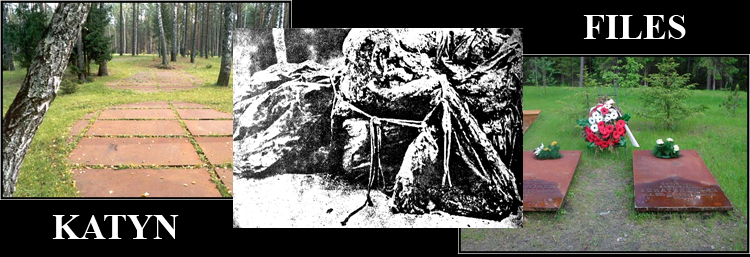Slave to the Game
Online Gaming Community
KATYN FILES, 1940
KATYN FILES, 1940
OFFICIAL GERMAN DOCUMENTARY EVIDENCE OF THE KATYN CASE
In 1943 the German authorities published a special report under the title: "The Official Statement Concerning the Mass Murder at Katyn. Collected, prepared and edited by the German Information Bureau on the basis of documentary evidence by order of the German Foreign Office."[Amthches Material zum Massenmord van Katyn. Im Auftrage aea Auswartigen Amtes auf Grund urkundlichen Beweismaterials zusammengestellt, bearbeitet und herauagegeben von der Deutschen mjormationastelle"—Berlin 1943.]
This volume of 330 pages begins with a short introductory section entitled "General Outline", followed by the "Documentary Evidence", divided in five chapters.
General outline
The "General Outline", six pages long, gives a resume of the whole case. The first few sentences present the Katyn crime in broad outline. There follows the account of events in chronological order, beginning with the discovery of the graves and the exhumation of 4,143 bodies. The total number of Polish victims buried in Katyn Forest is estimated to be 10,000—12,000. The gist of the official Soviet Statement, issued in reply to the German revelations, is then given, and the final conclusion is that the crime had been committed by the Bolsheviks. The third paragraph shows the development of Polish-Soviet relations and finally presents the attitude of Great Britain and the United States towards the Polish-Soviet conflict.
Documentary evidence I. Facts A.
Discovery of the mass graves: the evidence of Ludvig Voss
The evidence concerning the discovery of the mass-graves of Polish officers was given by Ludvig Voss, Secretary of the Secret Field Police, in the presence of the Judge, Doctor Iuris Conrad, and an Official of the legal office of Bornemann's Army.
This witness gave the details of the case and his personal data; he then explained that his duties consisted in supervising the exhumation work at Katyn and the police investigations.
His evidence was given on April 26, 1943, and the gist of it is as follows:
The first news of the mass-graves of Katyn was received at the beginning of February, 1943. Mounds with young pine-trees planted on them were found in the Katyn forest; on closer inspection it was discovered that they were caused by human agency. Preliminary excavations, carried out during the February frost, proved the existence of mass-graves. In view of the prevailing cold, work on a large scale could not be undertaken.
People living in the neighbourhood were called as witnesses in order to ascertain the facts. Then follows a list of the witnesses.
By special order of the German High Command (OKW), the excavation of the first grave was commenced on March 29, 1943. So far 600 bodies had been identified. There were about 3,000 bodies in the first grave. It was estimated that in the nearby graves a further 5,000 to 6,000 bodies would be found.
The identification so far carried out showed beyond all doubt that they were, almost without exception, the bodies of officers of the Polish Army.
All entries in the diaries and notebooks found on the bodies ceased on dates between April 6 and April 20, 1940.
B. Evidence by witnesses
In this part, the exact wording of the statements given by the witnesses during their interrogation is recorded.
The following persons were interrogated on the subject of the Kosogory Hill, near Katyn: Kusma Godonov, Ivan Krivozertsev, Michal Shigulov.
They all certified that since 1918 the hill had been generally known as a place of execution. It was used for executions in the time of the notorious "Tcheka", which later was replaced by the "GPU", and then by the "NKVD".
In 1931 the area in question was surrounded by an enclosure, and special signs were erected warning the inhabitants not to enter. From 1940 on, Kosogory was also guarded by sentries and police-dogs.
The report of the German Field Police, dated April 10, 1943, states that the graves Nos. 8-11 (a sketch was attached) contained the bodies of numerous civilians killed by means of pistol shots in the back of the head. The state of decay of those bodies indicated that the executions were carried out at various times prior to the war then in progress.
The following persons were interrogated on the subject of the transporting and killing of the prisoners-of-war in 1940: Ivan Krivozertsev, Matthiew Zakharov, Gregory Silvestrov, Ivan Andreyev, Parfeon Kisselev.
Krivozertsev saw trains arriving every day at Gniezdovo railway station during March and April;[The general winding-up of the Kozielsk camp started in the beginning of April 191,0, as many statements of the prisoners who survived amply bear out. Earlier, however, single persons or small groups were frequently taken away, many of them to disappear without trace. Those were probably the first victivis of Katyn Forest mass-murder ed as early as in March 1940.] they were composed of three to four carriages with gratings over the windows.
Zakharov, who was working at the railway station at Smolensk, also stated that train-loads of prisoners-of-war were arriving at that time. The prisoners were in Polish uniforms. Transportation of the prisoners in the direction of Gniezdovo railway station lasted for 28 days.
Silvestrov saw the railway carriages arriving at Gniezdovo and men in uniforms being detrained. Their personal baggage would be taken away from them and thrown on lorries (trucks), whilst the prisoners themselves would be put into three prison buses and driven towards Katyn. Sometimes the prison buses repeated the journey between Gniezdovo railway station and the NKVD Rest House ten times a day.
Andreyev saw trains arriving with the prisoners at Gniezdovo station in the months of March and April, 1940. There were Polish soldiers in the trains; he recognised them by the shape of their caps. They were put into motor vehicles and driven towards Katyn.
Kisselev said that for four to five weeks in the Spring of 1940 prisoners were brought to Kosogory in three to four buses daily. From his house he heard shots and shouts. It was rumoured that 10,000 Poles were shot there. In 1942, several Polish workmen attached to the German Army came to his house and asked him to show them the place where the Polish officers were said to have been buried, and to lend them a shovel. Later, these workmen told him that they had found the bodies of Polish officers.
The above evidence, here given in brief, was published by the Germans together with verbatim reports, personal data, photographs of signatures and testimonies of each witness.
C. Final Report of the German Police dated June 10, 1943
"The work of exhuming, examining and identifying the bodies of Polish officers came to an end on June 7, 1943. In the first place it must be stressed that the Kosogory forest was used as a place of execution of those sentenced to death by the NKVD or the Committee of 'The Three,' as early as 1925. Preliminary excavations undertaken in various parts of the wooded area invariably led to the discovery of mass-graves ('fraternal graves') in which the bodies of Russians of both sexes were found. Some of these bodies were carefully examined and it was proved that, without exception, death was caused by a shot in the back of the neck. From the documents found, it appeared that they were prisoners from the NKVD jail in Smolensk, the majority being political prisoners.
"The seven mass-graves of murdered Polish officers which have been cleared cover a relatively small area.
"Of 4,143 exhumed bodies, 2,815 have been definitely identified. Identification was based on identity cards, birth certificates, and award certificates found in their pockets together with their personal . correspondence.
"In many cases identity cards, documents and considerable sums in zloty banknotes were sewn into the legs of their boots. Their clothes left no doubt as to their being Polish officers, for instance, the long cavalry boots of a shape normally worn by Polish officers.
"A large number of hitherto unidentified bodies will undoubtedly be identified by the Polish Red Cross.
"The number of officers of various ranks is given below:
Generals 2
Colonels 12
Lt.-Colonels 50
Majors 165
Captains 440
Lieutenants 542
2nd Lieutenants 930
Paymasters 2
Warrant Officers 8
Other NCOs 2
Identified as officers 101
Identified as 'in uniform" 1,440
Medical Officers 146
Veterinaries 10
Chaplains I
Civilians 221
Names only identified 21
Unidentified 50
"Bodies identified as 'being in uniform" must also he regarded as officers, for corresponding epaulettes were often found in their pockets.
"After the identification (during which each body was given a serial number) and after the forensic medical examination, the bodies were buried in the newly-dug graves with the assistance of members of the Polish Red Cross. The new graves are numbered from 1 to 6 and the numbers can be found on the reverse side of the crosses. The two single graves of the generals were marked in a similar way.
"A name roll of all identified persons was made in order to facilitate meeting further enquiries from the families.
"From the translation of diaries, of memoirs and other notes found with the bodies, it was proved that the officers who had been taken prisoner by the Soviet Army in W9. were sent to various camps: Kozielsk, Starobielsk. Ostashkov. Putiviel. Bolotov. Pavlishehev Bor, Shepyctovka. Gorodok. The majority of those killed in Katyn Forest had been in the Kozielsk camp (250 kilometres south-east of Smolensk on the railway-line Smolensk-Tambov). A few are known to have been brought from Starobielsk to Katyn through kozielsk.
"From the end of March, until the first day of May. 1940. the prisoners from Kozielsk arrived by rail. The exact dates cannot be established A few short intervals apart, a batch left almost every day; the number of prisoners varied between 100 and 300 persons. . . All trains were sent to Gniezdovo near Smolensk. Thence, in the early morning, the prisoners proceeded in special lorries (trucks) to the Katyn Forest, situated three kilometres west of Gniezdovo. There the officers were immediately shot, thrown into the waiting graves and buried, as may be seen from the evidence of witness Kisselev. who had seen the ditches being prepared.
"That the shooting took place immediately after the arrival of a batch of prisoners is proved by witnesses who heard shots after every such arrival. There was no accommodation in the forest apart from the rest house, which had a limited capacity. The notes of Major Solski merit attention: the translation of his diary is preserved with other documentary evidence of the crime. Major Solski made a few entries in his diary during the last hour of his life.
"A certain number of spent pistol cartridge-cases with the stamp 'Geco 7,65 D' were found beyond the area of the graves; some single spent cases were found among the bodies in the graves. With a few exceptions, all the bodies show pistol-shots in the head; generally the place of entry of the bullet is below the protrusion at the back of the skull and the exit is in the forehead above the eye. (Cf. detailed photographs and the report of the medical expert. Professor Dr. Buhtz. as well as the evidence of a Polish doctor, Wodziriski.) In many instances the bullets had not left the skull. The calibre of the bullets found, 7.65 mm., would account for the damage to the skulls. The ammunition used was manufactured by the German firm of "Genschow". According to information given by the German High Command on May 31, 1943 (Ch.H.Rust und Befehlshaber des Ersatzheeresi. ammunition for pistols of that calibre and actual pistols were supplied to Soviet Russia and Poland. It remains to be established whether the ammunition and pistols came from Russian dumps or from Polish equipment captured by the Russians when they overran the eastern part of Poland.
"From the position of the bodies it may be assumed that the majority were murdered outside the graves. The bodies were in a complete tangle, except in graves Nos. 1, 2 and 4, where some of them lay side by side or on the top of each other. On some bodies spent cartridge cases were found between the collar of the victim's greatcoat and his neck, and there were holes in the collars of all the greatcoats. Every one of the collars was turned up. In other instances the bullets were found between the forehead and the inside of the cap. The number of persons shot in the graves totalled between 500 and 600.
"Very many of the dead men had their hands tied behind their back. In the case of a small number of bodies there was evidence that the head had been covered by the service dress or greatcoat and that a cord of the type used for hanging curtains had been tied round the neck.
"A few wedding rings and gold coins, etc., were the only valuables found in the victims" pockets. From the notes and diaries of the murdered persons it was evident that all valuables had been taken away from them in the camps. If anybody still possessed something of that kind, he had to hand it over immediately before the execution. They were left with zloty banknotes and these were found in great quantities.
"In spite of repeated announcements and searches, no eyewitnesses of the murders could be traced. The only known name is that of the administrator of the Rest House who lived there. The evidence of witnesses confirms that access to the forest was forbidden.
"Not all the bodies of the murdered officers had been exhumed when the work was interrupted, since a new grave of unknown capacity has recently been found. The possibility that further graves may come to light is not ruled out.
"The papers and personal effects were kept separately marked with the serial numbers of the victims and were always mentioned in routine reports.
"Voss, Secretary of the Field Police."
D. Report by Professor Dr. Gerhard Buhlz, in charge of forensic medical investigations (Excerpts only)
On March 1, 1943, I received for examination a report from the Secret Field Police dated February 28, 1943, concerning the discovery in Katyn Forest of mass-graves of Polish officers shot in 1940 by NKVD personnel. Together with the representatives of the Secret Field Police I carried out a number of experimental exhumations and myself soon became convinced that the evidence collected during the interrogation of the inhabitants of a nearby village was confirmed by the facts. The frozen ground did not then allow the exhumation and examination of the bodies to be started.
On the instructions of the German High Command the exhumation began on March 29,1943.
Eight graves
Up to June 1, 1943, seven mass-graves containing the bodies of officers of the Polish Army were found in the area of Katyn Forest. These graves were situated near each other in a clearing in the wood and had young pine trees planted on the top of them . . .
The seven graves occupied a total area of at least 478 square metres.
The depth of the various graves was between 1.85 and 3.30 metres. The central sector of the longer arm of the L-shaped grave was the deepest place. The differences in the depth could be explained by the varying levels of the bottom of the graves. Thus, the depth of grave No. 6 at its north-eastern end was 2.10, at the south-western end only 1.74 metres.
As a rule the graves were filled with bodies up to within 1.5 metres of the surface.
Grave No. 8 was discovered in the south-western part of the marshy lowiand on June 1, 1943, about 100 metres from the area occupied by graves Nos. 1 to 7 ...
In the woods north-east of die area of graves Nos. 1-7 on the other side of a forest track leading to the Rest House, and to the south-east of grave No. 8, several experimental excavations wen: carried out. They led to the discovery of the graves of many Rinnan civilians; this definitely confirmed previous information received to the effect that the Katyn forest had been used for many years as a place of execution of the victims of the NKVDand of its predecessors, the Cheka and GPU.
On June 3, 1943, the exhumation work had to be temporarily stopped by the sanitary police on account of the heat and the flies.
Protection and identification of the bodies
Doctor WodzMski, from Cracow, a representative of the Polish Red Cross, was recently made responsible for the work of protecting
the bodies, which service had previously been carried out by specially trained German personnel assisted by workmen recruited from among the local inhabitants.
All bodies exhumed from the seven graves were duly buried in new graves situated to the north-west of the original grave area. Thirteen bodies of Polish Army personnel from the grave No. 8 were re-buried in the same grave after examination and the securing of proofs of identity.
Results of the examination—general
All the bodies from graves Nos. 1-7 wore winter clothing, for the most part military greatcoats, leather or fur jerkins, pullovers and sweaters. Only two of the bodies exhumed from grave No. 8 on June 1, 1943, were in overcoats but not wearing warm underclothes; the remainder were in summer clothes (officers in service dress).
We may deduce from this that the executions were carried out at different times of the year; this is corroborated by the various Russian and Polish newspapers, whole or fragmentary, found amongst the victims' personal papers. Whilst the newspapers found in graves Nos. 1-7 were dated March or the first half of April. 1940. those found in grave No. 8 bore dates ranging from the latter part of April to the beginning of May, 1940. For example, there were fragments of the Polish newspaper Glos Radziecki fedited in Kiev), dated April 26 and 28, 1940, with an editorial headed "Catchwords for the First of May," as well as Russian newspapers dated May 1 and 6, 1940.
The uniforms in which the exhumed bodies were clothed were unquestionably those of the Polish Army, for with them were found the following articles: Polish eagles on the buttons, badges of rank, awards and medals, regimental badges, Polish type boots, field caps of officers and other ranks, belts with field flasks, aluminium cups, and markings on the linen. It must be pointed out that amongst the victims there were many officers of Marshal J. Pilsudski's First Cavalry Regiment. This is proved by shoulder-straps found in grave No. 8 with the letters "J.P." It was a crack Polish Cavalry regiment.
The highest awards for gallantry were found on many of the victims' uniforms; for instance, the Silver Cross "Virtuti Military" (corresponding to the German Knight's Cross), the Polish Cross of Merit, the Cross for Valour, etc.
For the most part the uniforms were well cut and a good fit; the boots too were well-fitting. Often personal monograms were found on the underclothing. In all instances the uniforms and the underclothes were well-buttoned. Braces and belts were in good order. Apart from a few instances of damage by bayonets, the clothing had not been interfered with and there were no traces of violence.
All these facts definitely lead to the conclusion that the victims were buried in the uniforms worn in captivity prior to their death, and that the bodies lay untouched until the opening of the graves. A theory, widely disseminated by the enemy, that the bodies were later dressed in Polish officers' uniforms is therefore without foundation. It is disproved by the results of the medical examination of the bodies; moreover, forensic medicine has taught us that it would be out of the question to remove the clothes of thousands of dead bodies and then, for the sake of camouflage, to clothe them in well-fitting linen and uniforms.
No watches or rings were found on the bodies; detailed entries in the diaries of certain of the victims indicate, however, that they had their watches with them up to the last. On one of the bodies a well-concealed emerald ring of great value was found; several other bodies had valuables concealed on them, particularly silver cigarette-cases. The gold from teeth had not been removed. Crosses, gold chains, etc., were found under the shirts.
Apart from small change (Polish paper money, nickel and copper coins), larger sums of money in zloty bank-notes were found on the victims. In many instances wooden, hand-made cigarette-cases were found together with partly-filled tobacco pouches, cigarette holders engraved with monograms, inscriptions and the dates 1939 or 1940. Often the word "Kozielsk" was engraved on articles; this is the name of the camp, situated 250 kilometres south-west of Smolensk and 120 kilometres north of Orel, where the majority of the murdered officers had been held. There was also personal correspondence from relatives and friends addressed to Kozictsk. Documents found on the victims (identity cards but not military passports diaries, letters, postcards, calendars, photographs, drawings, etc.) gave the name, age. profession, origin ami family relations of the victims. Pathetic entries in the diaries testily to the treatment of the victims by the NK.VI). I ellers ami postcards from relatives in Upper Silesia, in the "General Government" and in the Russian occupied zone, written, to judge the post-office stamps, between Autumn. 1939, and March or April, 1940. clearly point to the time of the crime (Spring, l940).
Summary
(1) As a result of the investigaitions in Katyn Forest 4,143 bodies of the members of the Polish Army were exhumed from the-massgraves. Out of this number 2.815 (67.0 per cent) were identilied. On June 3, 1943, the exhumation had to be stopped for sanitary reasons (heat, flies). A lot more victims await exhumation, identification and forensic medical examination.
(2) Besides two major-generals, the following victims were identified on the spot: 2,250 oflicers of various ranks, 156 medical and veterinary officers, 406 officers of unknown rank, warrant-oflicers and cadet-oflicers, and one chaplain. Identification of the remaining bodies continues, based on correspondence and other personal effects found upon them.
(3) On all the bodies were found small objects of a personal nature, including souvenirs, letters, documents, diaries. They wore well-fitting Polish uniforms on which the rank badges, awards and medals could be recognised. In addition, many articles of military equipment were found on the bodies. The bodies from graves Nos. 1-7 were in winter clothing, those from grave No. 8 in summer clothing.
(4) Upon examination of the bodies, there was no suggestion that
disease might have been the cause of death. With a few exceptions
the usvial bullet shot in the nape of the neck from a 7.65 mm. pistol
was found. Corroboration is provided by corresponding spent
cartridge-cases anil bullets (some lodged in the bodies) and by one
live cartridge found at the place of execution. In many instances the
shots in the nape of the neck hnd passed through (he raised collar of
the greatcoat. Up-to-date physical, chemical and optical methods of
investigation showed that the shots were fired at extremely close
range.
(5) The execution most probably took place outside the graves.
(6) A uniform method of binding the hands ucross (he back had been used on a considerable number of the victims. Others (particularly those from grave No. 5) had greatcoats thrown over their heads and in some cases sawdust was found between the coat and the face of the victim. Forensic medical examination brought to light distinct signs of torture.
(7) Numerous stab-marks were found, undoubtedly inflicted prior to the execution with a dagger-like weapon corresponding to the fluted Russian bayonet. No doubt these stabs were a means of urging the victims on their way to the place of execution.
(8) Broken jaws, obviously suffered by the victims when they were still alive, prove that they were battered or beaten with rifle-butts prior to the murder.
(9) The uniform shot in the nape of the neck and the uniform method of tying the victim's hands and binding his head show that this was the work of skilled men.
(10) The bodies were in various stages of decay. In a few cases mummification of the uncovered parts had taken place (bodies from the upper layers), but generally the formation of adipocere had started with the fat penetrating into the clothing.
(11) Initially, the decomposition of the bodies was not affected by
the ground, but after some time it was partly influenced by the acids
in the soil (formation of adipocere and preservation of inner organs).
On the other hand the products of the decomposition caused characteristic (chemical and structural) changes in the soil. These phenomena
show that the bodies lay undisturbed for years in their original place.
(12) The material discovered in the graves (amongst others, documents found there) and the evidence of witnesses (Russian inhabitants of the neighbouring villages) prove that the bodies had lain in the graves for three years. The changes that had taken place, as ascertained during the post mortem, and the other findings at the inquest, bear this out.
(13) The execution and the burial of the victims were carried out in a cool season, when there were no insects. The documents, correspondence, diaries and newspapers found on the bodies prove that the officers were murdered in March, April and May, 1940.
Then follows the report of the International Medical Commission which the Germans invited to Katyn.
REPORT OF THE INTERNATIONAL MEDICAL COMISSION
In early May, 1943, the following report was published by an International Medical Commission which conducted an investigation into the mass-graves at Katyn Forest on the invitation of the German authorities:
1. Official communique
"A Commission consisting of the representatives from the Institutes of Forensic Medicine and Criminology of European Universities, as well as of other professors of medicine, conducted a scientific examination of the mass-graves of Polish officers in Katyn Forest near Smolensk, between April 28 and 30, 1943.
The Commission was composed of the following members:
(1) Belgium Speelers, M.D. Professor of Ophthalmology, Ghent University.
(2) Bulgaria Markov, M.D. Reader in Forensic Medicine and Criminology, Sofia University.
(3) Denmark Tramsen, M.D. Assistant at the Institute of Forensic Medicine in Copenhagen.
(4) Finland Saxen, M.D. Professor of Pathological Anatomy, Helsinki University.
(5) Croatia Miloslavich, M.D. Professor of Forensic Medicine and Criminology, Zagreb University.
(6) Italy Palmieri, M.D. Professor of Forensic Medicine and Criminology, Naples University.
(7) Holland
De Burlet, M.D. Professor of Anatomy, Groningen University.
(8) Bohemian and Moravian
Protectorate Hajek, M.D. Professor of Forensic Medicine and Criminology, Prague University.
(9) Rumania Birkle, M.D. Expert in Forensic Medicine at the Rumanian Ministry of Justice.
(10) Switzerland Naville, M.D. Professor of Forensic Medicine and Criminology, Geneva University.
(11) Slovakia Subik, M.D. Professor of Pathological Anatomy, Bratislava University.
(12) Hungary Orsos, M.D. Professor of Forensic Medicine and Criminology, Budapest University.
"Further, the investigations and meetings of the Commission were attended by:
(1) Buhtz, M.D. Professor of Forensic Medicine and Criminology at Breslau (Wroclaw) University, entrusted with the exhumation work at Katyn by the German High Command.
(2) Costedoat Medical Inspector, attending the work of the Commission on behalf of the Head of the French Government.
"The discovery of the mass-graves of Polish officers in Katyn Forest, near Smolensk, recently brought to the attention of the German authorities, induced Doctor Conti, the Head of the Reich Health Department, to ask the above-mentioned specialists from various European countries to investigate the Katyn -discovery and thus to assist in elucidating this unique case.
"The Commission personally questioned a number of Russian witnesses from the vicinity who testified that in March and April, 1940, large transports of Polish officers arrived almost daily at the railway station of Gniezdovo, near Katyn, where they were unloaded and sent in lorries (trucks) towards the Katyn forest, never to be heard of again. The Commission also examined the discoveries and the results of previous investigations, as well as such evidence as had been collected. Up to April 30, 1943, 982 bodies had been exhumed. Of these, about 70 per cent were gradually identified; documents found on the remaining victims could not be used for identification until they had been properly cleaned. All bodies exhumed prior to the arrival of the Commission had been examined and in most cases a post mortem had been carried out by Professor Buhtz and his colleagues. Up till now seven mass graves have been excavated. The largest contained the bodies of about 2,500 officers.
"The members of the Commission personally conducted a post mortem on nine of the bodies, and proceeded to establish the evidence in specially selected cases.
Results of autopsies and forensic medical examinations
"All bodies so far exhumed show that death was caused by a shot in the head. These shots were without exception fired into the nape of the neck; generally one shot had been fired, in some instances two, and in one instance three. In every case the bullet had entered the lower part of the nape, piercing the occipital bone, close to the opening of the lower part of the skull; the point of exit was in the forehead, generally on the line of the hair-growth, in some rare cases in the lower part of the forehead. The shots were without exception those of a pistol with a calibre of less than eight millimetres.
"That the shots had been fired from a barrel touching the nape of the neck or at extremely close range is proved by the cracks in the skull, by traces of gunpowder on the base of the skull close to the entrance of the bullet, and by the similarity of the exit orifices caused by the bullet. This may also be deduced from the fact that, apart from a few isolated cases, the path of the bullet is identical. The striking uniformity of the injuries and the position of the bullet's entry, all within a very small circumference on the lower part of the skull, point to experienced hands having been at work. The wrists of a large number of victims were found to have been tied in exactly the same way and in a few cases light bayonet stabs were noticed in the skin and in the clothes. The way in which the hands of the victims were tied is similar to that observed in the case of corpses of Russian civilians, also exhumed in Katyn Forest, but buried much earlier. Further, it has been established that the shots in the nape of the neck of these civilians had likewise been the work of experienced men.
"A stray bullet which had penetrated the head of a Polish officer previously killed by the usual shot in the nape of the neck, and which was wedged in the exterior part of the bone, proves that the bullet first killed another officer and then struck this officer who already lay dead in the pit. This fact warrants the assertion that shooting also took place in the pits themselves, in order to avoid transferring the corpses to the burial ground.
"The mass-graves are situated in clearings, which had been completely levelled and then planted with pine trees. According to personal examinations carried out by the members of the Commission and the statements of senior forestry inspector Von Herff, who had been summoned as an expert, the pine trees in question were at least five years old, rather stunted owing to their being in the shade of older trees, and had been planted in that area three years ago.
"The pits were dug in stepped terraces in a hilly area and in sandy soil. In places they penetrated to underground water.
"The bodies were almost without exception laid face downwards, pressed together, fairly tidily around the sides of the pit but more irregularly in the centre. In almost all cases the legs were extended. It is clear that the bodies were arranged systematically. The Commission observed that the uniforms of the exhumed bodies, especially in respect of buttons, badges of rank, decorations, boots, marks on the underwear, etc., were typically Polish. The uniforms in question were winter ones. Fur coats, leather jackets, pullovers, officers' boots and caps customarily worn by Polish officers were frequently found. Only a few bodies of other ranks were discovered; the body of a priest was also found. All the uniforms were well-fitting despite the varying sizes of the wearers. The underclothes were buttoned up in the normal way; the braces of the trousers were properly adjusted. The Commission arrived at the conclusion that the victims were buried in the uniforms worn by them up to the moment of their death.
"No watches or rings were found on the bodies although, judging from the entries in the notebooks in which the exact time had been recorded, the officers must have been in possession of watches until the last moment. Valuable articles of metal were found concealed on a few bodies only. Bank-notes were found in large quantities and quite often some small change. Boxes of matches and Polish cigarettes were also found, and in some cases tobacco pouches, and cigarette cases bearing the inscription 'Kozielsk' (the name of the last Russian POW camp where the majority of the murdered officers had been imprisoned). The documents found on the bodies (notebooks, letters, newspapers) bear the dates covering the period between the Autumn of 1939 and the months of April and March, 1940. So far, the most recent date that has come to light is that on a Russian newspaper dated April 22, 1940.
"The stages of decay were found to vary in accordance with the position of the bodies in the pits. Whilst mummification had taken place on the top and at the sides of the mass of bodies, a humid process could be observed caused by the damp nearer the centre. Adjacent bodies were stuck together with a thick putrid liquid. The peculiar deformations due to pressure clearly show that the bodies remained in the position they had assumed when they were first thrown into the pits.
"Neither insects nor any traces of them, such as could have dated from the time of the burial, were found on the bodies. This proves that the shooting of the victims and their burial took place in the cold season, when there were no insects.
"Several skulls were examined with a view to seeing whether they showed a condition which, if present, constitutes, according to the experiments made by Professor Orsos, clear evidence regarding the date of death. This appears as a crust, formed of layers of necrotic structure, around the surface of the brain which is turned into a uniform clay, like pulp. Bodies that have been in graves less than three years do not show this condition. Amongst others, body No. 526, which was discovered on the surface of a big mass grave, bore distinct traces of this phenomenon.
Recapitulation
"The Commission has examined the mass-graves of Polish officers in Katyn Forest. So far seven of these graves have been opened. Up to the present a total of 982 bodies has been exhumed and examined. Some of them have been submitted to a detailed post-mortem examination. Seventy per cent of the bodies have been identified.
"The death of all these victims was caused exclusively by a shot in the nape of the neck. From statements made by witnesses, as well as from letters, diaries, newspapers, etc. found on the bodies, it follows that the executions took place in March and April, 1940. There is a complete conformity between the statements concerning the mass-graves and the results of the examination of single bodies of Polish officers."
The above experts' report was signed at Smolensk on April 30, 1943, by the following persons: Speelers, Markov, Tramsen, Sax6n, Pahnieri, Miloslavich, De Burlet, Hajek, Birkle, Naville, Subik, Orsos.
2. The origin of the International Medical Commission and the method of investigation
Professor Palmieri gave to the Polish military authorities in Naples, in 1944 the following information concerning the origin of the Commission, the members of which had been invited by the Germans and of the method employed by the investigators.
The Commission was summoned after the refusal of the International Red Cross to participate in the investigation. As is known, the International Red Cross in Switzerland was obliged to refuse,
because it had not received the necessary authorisation from the Soviet Government. In view of the foregoing, the German Government decided to organise their own investigations, by entrusting the enquiry into the Katyn crime to the best-known European specialists in forensic medicine. A delegate of the Polish Government in London was invited to join the Commission, but he declined.
Thirteen delegates of various countries met in Berlin. German scientists did not partake in the work of the Commission ; Doctor Buhlz, Professor of Forensic Medicine at the University of Breslau (Wroclaw), merely acted in a liaison capacity between the Commission and the German authorities.
From the very beginning, that is to say at the preliminary meeting of the Commission, it was unanimously decided that the investigations should be conducted on purely a scientific basis, excluding all political or polemic aspects. The Commission then proceeded to formulate the questions to which they would limit themselves, viz.:
(1) Identification of bodies.
(2) Ascertaining the cause of death.
(3) Establishing the time at which death occurred.
It must be stressed that during the entirely impartial investigations and the drawing-up of the well-known conclusions unanimously adopted, the Commission adhered strictly to the above-mentioned rules.
All members of the Commission enjoyed absolute freedom of movement and were provided with such technical means as might be of help to them. They were allowed to go to the graves in order to direct the exhumation in the places and under the conditions that they deemed suitable. A Commission of the Polish Red Cross which had arrived from Warsaw worked simultaneously but separately at Katyn and arrived at the same conclusions.
On their return to Berlin, the members of the Commission handed over their report to Doctor Conti, the Head of the Reich Health Department, and the Commission was then disbanded.
It must be emphasised that the work of the members of the Commission was entirely honorary. None of them received any salary or allowance, decoration or academic distinction, or any other compensation whatsoever. They merely received railway tickets and their hotel bill, were settled on the spot.
3. Dr. Markov's revocation
The Bulgarian expert, Dr. Markov, lecturer at the University of Sofia, subsequently revoked his signed statement, included in the report of the International Medical Commission. He did it for the first time in February, 1945, when arraigned before the Highest Military Court for leading German war criminals in Bulgaria, which court had been established after the German troops had withdrawn from that country, the Soviet army had overrun Bulgaria and the Communist regime was established there. In consequence of this revocation, the Prosecutor withdrew his indictment against Dr. Markov.
At Nuremberg on July 1, 1946, Dr Markov repeated the evidence he had given before the People's Tribunal in Sofia.
4. Report of a Swiss Professor, Francois Naville, of January, 1947
In September, 1946, when the Nuremberg Trial was nearing its end, a Communist member of the Swiss Grand Council, Mr. Vincent (Swiss Communists ostensibly belong to the "Labour Party"), deemed it expedient to launch an attack against Professor Francois Naville on account of his participation in an International Medical Commission which in 1943 had conducted an investigation at Katyn and later published its well-known report. Mr. Vincent chose the form of an interpellation addressed to the Geneva Executive Body (State Council).
This interpellation had its repercussion at a sitting of the Geneva Legislative Body (Grand Council) in 1947, when Mr. Albert Picot, Head of the Cantonal Government, answered Mr. Vincent's case. A substantial part of this answer consisted in reading extracts from Professor Naville's report, presented by the latter to the Government, at their request, following the interpellation. The following is the substance of M. Albert Picot's statement.
At the meeting of the Grand Council of September 11, 1946, a member, Mr. Vincent, asked the Council of State how they proposed to judge the case of Dr. Naville, Professor of Forensic Medicine, who had agreed to act as legal expert at the request of the German Government in April, 1943, where the origin of the 10,000 corpses of Polish officers discovered in Katyn Forest near Smolensk was concerned. It is known that Katyn is in Russia, in a region which the Russians had occupied since the beginning of the Polish-German war in 1939, and where the Germans had not arrived until the Summer or Autumn of 1941, after the first successes of their offensive in the direction of Smolensk.[ Smolensk and Katyn are actually situated in an area which lay inside the borders of the USSR before1939.]
If the killings took place in 1940 or the Winter of 1940-41, then these men were executed by the Russians. If the corpses dated from the Autumn of 1941 or from 1942, then the murderers were Germans.
Considering the climatic conditions, the question could be decided by the advanced state of decomposition of the bodies.
In its report the State Council would deal only with the following three points:
(1) The relations between Mr. Naville and the Swiss authorities (federal, cantonal and military) before his departure.
(2) Did Mr. Naville receive any reward from Germany?
(3) Did Mr. Naville agree to work under conditions of constraint, thus soiling the honour of a Swiss Professor?
On all these three questions they were in possession of a clear report from Mr. Naville, and he was happy to read them extracts from it: Preamble
"I wish to state that in the present circumstances I have been obliged for the first time to abandon the restraint which I deliberately undertook to exercise for the last three years. I am not mixed up with politics. I consider that I did my duty by participating in the technical enquiry with a view to throwing some light on the matter concerned, and I have always refused to follow up the numerous requests addressed to me, either by Swiss or by foreigners, to make public my findings or my opinion. Rightly or wrongly, I considered that only the Poles, who had asked for an enquiry into the circumstances in which some ten thousand of their officers, prisoners-of-war, had been killed, could assume the responsibility of initiating a public discussion on the subject, of which the consequences could not be foretold.
"But the intervention of Mr. Vincent forces me to give certain information on the matter.
Conditions of request and acceptance
"1 recall that after the Germans had uncovered the ditches containing several thousand Polish officers, killed, according to them, by Russian secret police, the Polish Government in London as well as the Polish and German Red Cross asked the International Committee of the Red Cross to conduct an investigation on the spot. As Russia seemed determined to veto such an enquiry, the German sanitary authorities, in order to accede to the wishes of the Poles, decided to entrust the investigation to a committee of experts composed of one specialist in forensic medicine from almost every neutral country, that is, each country not directly interested in the matter.
"The Russians, considering that the demand for an impartial investigation submitted by the Poles was a hostile act on their part, severed diplomatic relations with the Polish Government on Monday, April 26, 1943. This I was told by the Swiss Envoy in Berlin, Mr. Frohlicher, on whom I called immediately after my arrival in Berlin…
"It was on the night of April 22, 1943, that Dr. Steiner, of Geneva, medical adviser to the German Consulate General there, asked me whether I could and would leave on April 26 to join the committee of experts concerned. May I add in this connection that I have never concealed from anybody my outspoken, and I may even say violent, hostility towards Germany after 1914, caused by their foreign policy which I always considered dangerous for Switzerland, and since 1933 by the attitude adopted by the Nazi bosses. I could give many proofs of this. It was well known to my students at the University, as even the late German Professor Askanasy occasionally protested to me about it. Your department can ascertain from Professor Liebeskind what I said after incidents provoked by one of his lectures to German students, and from the Dean of the Faculty of Law the way in which I intervened in connection with the affair of the German student-spies.
"Therefore I refused at first, and suggested some other Swiss experts in forensic medicine. In the meantime, however, I contacted other persons. They told me that this was not a matter of rendering a service to the Germans, but of responding to the legitimate wish of the Poles, who demanded that an impartial investigation be made, and that it should be established whether anything had been done to produce a nominal roll of the dead officers, to proceed with the identifications as far as possible, and to inform the next-of-kin. Here I must remind you that, contrary to the practice followed by all the other belligerents, the Russians always refused to supply lists of prisoners-of-war taken by them to the International Committee of the Red Cross, and that for a long time no news had been received of the 10,000 officers they had taken prisoner.
"When Dr. Steiner again invited me, therefore, I decided to accept; if I am not mistaken it was on Friday night. It seemed to me that it would be cowardly to refuse to co-operate in an enquiry whose object was to establish the truth, under the pretext that I would necessarily be dissatisfied with one or the other of the belligerents accused of a crime so particularly odious and contrary to the modern usages of war. At that time, moreover, I did not know what the composition of the committee of experts would be, or even what would be submitted to me for examination and enquiry."
Departure
Professor Naville's report goes on to state that he was authorised to take part in the Medical Commission of Investigation both by the Swiss military authorities and by the Federal authorities (Political Department). In accordance with the regulations he advised the Dean of his Faculty, who neither at that time nor at any later period, raised any objection. Next, the report deals with the question of the fees which the Germans were supposed to have paid to the members of the Commission:
Fees
"Mr. Vincent seems to be under the impression that I received a considerable amount of German gold. He can be relieved of his anxiety. I was certainly entitled to ask for a fee for such complicated work of such importance, on which I spent one month of my time carrying out various researches, after a journey taking eight days. But from the very beginning I decided to refuse it, on moral grounds. I did not want to obtain money either from the Poles or from the Germans. I do not know who paid the expenses of the journey of our committee of experts, but I personally never asked for nor received from anyone any gold, money, gifts, rewards, assets, or promises of any kind. If, at a time when it is being mauled simultaneously by the armies of two mighty neighbours, a country learns of the massacre of nearly 10,000 of its officers, prisoners-of-war, who committed no crime other than to fight in its defence, and when that country tries to find out how this came about, a decent man cannot demand fees for going to the place and trying to lift the hem of the veil which concealed, and still conceals, the circumstances in which this act of odious cowardice, so contrary to the usages of war, was committed.
Conditions of work
"Mr. Vincent asserts that I was acting under constant pressure from the Gestapo, which prevented us from having a free hand. This is absolutely untrue. I do not know whether the police were represented amongst those who received and accompanied us (doctors and guides), but I can definitely state that we were able to proceed undisturbed with our work as experts. I did not notice any signs of pressure being exerted on myself or on any of my colleagues. We were always able to discuss all matters freely amongst ourselves without the Germans being present. On many occasions I told my co-experts and the Germans who received us certain 'truths' which they considered rather outspoken. They seemed dumbfounded, but no one ever molested me. I did not conceal what I thought of the moral responsibility of the Germans in this matter, as it was they who went to war and invaded Poland, even if our conclusions should establish their innoncence in the matter of the death of the officers.
"We spent two days and three nights at Smolensk, about 50 km. from the Russian lines. I moved about quite freely at Smolensk, as in Berlin, without being in any way accompanied or shadowed. As two of us could speak Russian, we were on several occasions able to talk to the peasants and Russian prisoners-of-war. We also contacted the medical personnel of the Polish Red Cross, who co-operated at the exhumation, and were specially detailed to identify the bodies, make nominal rolls and inform the next-of-kin. We assured ourselves that everything possible was being done in that respect.
"We freely carried out about ten post mortem examinations of bodies which we had had taken, in our presence, from the lower layers of the unexplored common graves. Undisturbed, we dictated reports on the post mortem examinations, without any intervention from the German medical personnel. We examined, superficially but quite freely, about one hundred corpses which had been disinterred in our presence. I, myself, found in the clothes of one of them a wooden cigarette-holder engraved with the name 'Kozielsk' (one of the three camps from which the doomed officers had come), and in the uniform of another I found a box of matches from a Russian factory in the Province of Orel, the region where the three camps concerned were situated.[0nly Koziehk was in fact situated in the region of Orel.]
"At the examinations, being concerned with the forensic medicine aspect, we paid particular attention to the transformation of the fatty substances of the skin and internal organs, to changes in the bones, to the destruction of joint tendons, to changes and atrophies of various parts of the body, and also to all other signs which would testify to the time of death.
"Examination of the skull of a lieutenant, undertaken specifically by Professor Ors6s from Budapest, at which I was present, brought to light a condition that virtually excluded the possibility of death having occurred less than three years previously, according to scientific works already published on that kind of mutilation. . . .
"We experts were also at liberty to discuss amongst ourselves all our findings as well as the wording of our report. After having examined the graves and the corpses on Thursday and Friday, 29 and 30 April, all the experts met on Friday afternoon to discuss and decide on the composition of the report. Only medical personnel took part in that discussion, but without any interference. Some of us made a draft of the final report, and it was submitted to me for signature on Saturday, May 1, at 3 a.m. I offered several comments and asked for some changes and additions, which were immediately made. I do not know whether the same consideration was given to the observations and criticisms made by Dr. Markov of Bulgaria; I do not remember whether he intervened during our discussion at the meeting, but I was present when he signed the report on May 1 about noon, and I can state that he did not then make any objections or protests. I do not know whether he was subject to any constraint by the authorities of his own country, either before the journey to Katyn or at the time he revoked his signature, on being charged with collaboration and when he declared that he had acted under pressure; but he was certainly not under any pressure or constraint while the committee of which he was a member was at work. In any case, he made in our presence a post mortem of one corpse and quite freely dictated the report on it, of which I have a copy. . . .
"By joining the twelve other experts in signing our report of 1943, I by no means wished to serve the Germans, but only the Poles and the Truth. The report, by the way, occupies only five pages in the thick illustrated volume of 331 pages which the Germans published about Katyn, which I possess, and which I was told is also in the possession of the public library in Geneva.
"Mr. Vincent is a solicitor in Geneva. He knows that even in our country, in matters where a public confession or substantial evidence have not entirely clarified matters, the parties concerned try to take advantage of all the obscure points. He also knows that not everywhere in Europe are the rights of man and the truth unsullied by the ideological and political trends of the day respected as they are, happily, in Switzerland.
"As for us, the forensic medicine experts, it is our right and our duty in our modest sphere to seek above all to serve the truth in conflicts where the parties sometimes serve other masters; it is the tradition and the pride of our profession, an honour sometimes dangerous. We must do this without yielding to pressure, from whatever quarter it may come, without regard for the criticism and hostility of those who may be put into an awkward position by our unbiased impartiality. May our motto always remain that which honours certain tombs: Vitam impendere vero.
"Here, Mr. President, is the report you asked me to submit in justification of my actions. I leave it to you to decide whether it would be appropriate to contact the Federal Political Department, with whose consent I took part in the experts' examination in question, before you submit the text or its gist to the Grand Council, which might have political consequences I cannot foresee.
(signed) F. Naville."
Mr. Picot's statement
Those, continued Mr. Picot, were the parts of the report submitted by Dr. Naville that concerned them most.
"The State Council considers that there is nothing with which to reproach Dr. Francois Naville, distinguished man of science, excellent forensic medicine expert, who acted on his own responsibility and who did nothing to infringe any rule of professional conduct or of the code of honour. Dr. Naville's report contains a statement justifying the conclusions of his original report of 1943. He may publish it when he wishes. The Grand Council is not entitled to make any pronouncement on this matter.
"On the other hand, the Grand Council agrees with us that it is in accordance with the ideal of science and the moral principles of our country that a scientist should seek the truth by means of thorough investigation."*
THE SOVIET OFFICIAL STATEMENT
The detailed Soviet official statement on the Katyn murder was published in the farm of a report of a special commission on January 24, 1944. Entitled "The Truth About Katyn —Report of Special Commission for Ascertaining and Investigating the Circumstances of the Shooting of Polish Officer Prisoners by the German-Fascist Invaders in the Katyn Forest", it appeared in English in London as a Special Supplement to the Soviet War Weekly of February 3, 1944. This report, which we reprint in full, reads as follows:
"The Special Commission for Ascertaining and Investigating the Circumstances of the Shooting of Polish Officer Prisoners by the German-Fascist Invaders in the Katyn Forest (near Smolensk) was set up on the decision of the Extraordinary State Commission for Ascertaining and Investigating Crimes Committed by the German-Fascist Invaders and Their Associates.
The Commission consists of: Member of the Extraordinary State Commission Academician Burdenko (Chairman of the Commission); member of the Extraordinary State Commission Academician Alexei Tolstoy; member of the Extraordinary State Commission the Metropolitan Nikolai; President of the All-Slav Committee, Lt.-Gen. Gundorov; the Chairman of the Executive Committee of the Union of the Red Cross and Red Crescent Societies, Kolesnikov; People's Commissar of Education of the Russian S.F.S.R. Academician Potemkin; the Chief of the Central Medical Administration of the Red Army, Col.-Gen. Smirnov; the Chairman of the Smolensk Regional Executive Committee, Melnikov. To accomplish the task assigned to it the Commission invited the following medico-legal experts to take part in its work: Chief Medico-Legal Expert of the People's Commissariat of Health Protection of the U.S.S.R., Director of Scientific Research in the Institute of Forensic Medicine Prozo-rovsky; the Head of the Faculty of Forensic Medicine at the Second Moscow Medical Institute, Doctor of Medicine Smolyaninov; Senior Staff Scientists of the State Scientific Research Institute of Forensic Medicine under the People's Commissariat of Health of the U.S.S.R.
Semenovsky and assistant Professor Shvaikova; Chief Pathologist of the Front, Major of Medical Service, Professor Voropayev.
The Special Commission had at its disposal extensive material presented by the member of the Extraordinary State Commission Academician Burdenko, his collaborators, and the medico-legal experts who arrived in Smolensk on September 26, 1943, immediately upon its liberation, and carried out preliminary study and investigation of the circumstances of all the crimes perpetrated by the Germans.
The Special Commission verified and ascertained on the spot that 15 kilometres from Smolensk, along the Vitebsk highway, in the section of the Katyn Forest named "Kozy Gory," 200 metres to the S.W. of the highway in the direction of the Dnieper, there are graves in which Polish war prisoners shot by the German occupationists were buried.
On the order of the Special Commission, and in the presence of all its members and of the medico-legal experts, the graves were excavated. A large number of bodies clad in Polish military uniform were found in the graves. The total number of bodies, as calculated by the medico-legal experts, is 11,000. The medico-legal experts made detailed examinations of the exhumed bodies and of documents and material evidence discovered on the bodies and in the graves.
Simultaneously with the excavation of the graves and examination of the bodies, the Special Commission examined numerous witnesses among the local residents, whose testimony establishes with precision the time and circumstances of the crimes committed by the German occupationists.
The testimony of witnesses reveals the following.
The Katyn Forest
The Katyn Forest had for long been the favourite resort of Smolensk people, where they used to rest on holidays. The population of the neighbourhood grazed cattle and gathered fuel in the Katyn Forest up to the outbreak of war. Even in the summer of 1941 there was a Young Pioneers' Camp of the Industrial Insurance Board in this forest, and it was not liquidated until July, 1941.
An entirely different regime was instituted in the Katyn Forest after the capture of Smolensk by the Germans. The forest was heavily patrolled. Notices appeared in many places warning that pcr-yons entering without special passes would be shot on the spot.
The part of the Katyn Forest named "Kozy Gory" was guarded particularly strictly, a«. wa-» the area on the bank of the Dnieper, where 7fJ0 metre* from the graves of the Polish war prisoners, there was a country house—the rest home of the Smolensk Administration ef the Peoples' Commissariat of Internal Affairs. When the Germans arrived this country house was taken over by a German institution named "Headquarters of the 5.*7th ftngineerine Battalion."
Polish war prisoners in Smolensk area
The Special Commission established that, before the capture of Smolensk by the Germans, Polish war prisoners, officers and men, worked in the western district of the Region, building and repairing roads. 'These war prisoners were quartered in three special camps named: Camp No. I O.N., Camp No. 2 O.N. and Camp No. .1 O.N. These camps were located 25-45 kilometres west of Smolensk.
The testimony of witnesses and documentary evidence establish that after the outbreak of hostilities, in view of the situation that arose, the camps could not be evacuated in time and all the Polish war prisoners, as well as some members of the guard and staffs of the camps, fell prisoner to the Germans,
The former Chief of Camp No. 1 O.N., Major of State Security Vetoshnikov, interrogated by the Special Commission, testified: "I was waiting for the order on the removal of the camp, but communication with Smolensk was cut. Then I myself with several stall members went to Smolensk to clarify the situation. In Smolensk 1 found a tense situation. 1 applied to the chief of traliic of the .Smolensk section of the Western Railway, Ivanov, asking him to provide the camp with railway cars for evacuation of the Polish war prisoners. But Ivanov answered that I could not count on receiving cars. I also tried to get in touch with Moscow to obtain permission to set out on foot, but 1 failed. By this time Smolensk was already cut oil from the camp by the Germans, and [I do] not know what happened to the Polish war prisoners and guards who remained in the camp."
Engineer Ivanov, who in July, 1941, was acting Chief of Traffic of the Smolensk Section of the Western Railway, testified before the Special Commission: "The Administration of Polish War Prisoners' Camps applied to my office for cars for evacuation of the Poles, but we had none to spare. Besides, we could not send cars lo the Gussino line, where the majority of the Polish war prisoners were, since that line was already under lire. Therefore, we could not comply with the request of the Camps Administration. Thus the Polish war prisoners remained in the Smolensk Region."
Tlie presence of the Polish war prisoners in the camps in the Smolensk Region is confirmed by the testimony of numerous witnesses who saw these Poles near Smolensk in the early months of the occu pation up to September, 1941, inclusive.
Witness Maria Alexandrovna Sashneva, elementary schoolteacher in the village of Zenkovo, told the Special Commission that in August, 1941 she gave shelter in her house in Zenkovo to a Polish war prisoner who had escaped from camp.
"The Pole wore Polish military uniform, which I recognised at once, as during 1940 and 1941 I used to see groups of Polish war prisoners working on the road under guard. ... I took an interest in the Pole because it turned out that, before being called up, he had been an elementary schoolteacher in Poland. He told me that he had completed normal school in Poland and then studied at some military school and was a Junior Lieutenant of the Reserve. At the outbreak of war between Poland and Germany he was called up and served in Brest-Litovsk, where he was taken prisoner by Red Army units. . . . He spent over a year in the camp near Smolensk.
"When the Germans arrived they seized the Polish camp and instituted a strict regime in it. The Germans did not regard the Poles as human beings. They oppressed and outraged them in every way. On some occasions Poles were shot without any reason at all. He decided to escape. Speaking of himself, he said that his wife, too, was a teacher and that he had two brothers and two sisters. . . ."
On leaving next day the Pole gave his name, which Sashneva put down in a book. In this book. Practical Studies in Natural History, by Yagodovsky, which Sashneva handed to the Special Commission, there is a note on the last page: "Juzeph and Sofia Loek. House 25. Ogorodnaya St., town Zamostye." In the list published by the Germans, under No. 3796 Lt. Juzeph Loek is put down as having been shot at "Kozy Gory" in the Katyn Forest in the spring of 1940. Thus. from the German report, it would appear that Juzeph Loek had been shot one year before the witness Sashneva saw him.
The witness Danilenkov. a peasant of the "Krasnaya Zarya" collective farm of the Katyn Rural Soviet, stated: "In August and September. 1941. when the Germans arrived, I used to meet Poles working on the roads in groups of 15 to 20.'"
Similar statements were made by the following witnesses: Soldaten-kov, former headman of the village of Borok; Kolachev. a Smolensk doctor ; Ogloblin. a priest; Sergeyev, track foreman ; Smiryagin. engineer : Moskovskaya. resident of Smolensk ; Alexeyev, chairman of a collective farm in the village of Borok; Kutseev, waterworks technician ; Gorodetsky. a priest; Bazekina. a bookkeeper; Vetrova, a teacher; Savvateyev. stationmaster at the Gnezdovo station, and others.
Round-ups of Polish war prisoners
The presence of Polish war prisoners in the autumn of 1941 in Smolensk districts is also confirmed by the fact that the Germans made numerous round-ups of those war prisoners who had escaped from the camps.
Witness Kartoshkin, a carpenter, testified: "In the autumn of 1941 the Germans not only scoured the forests for Polish war prisoners, but also used police to make night searches in the villages."
Zakharov, former headman of the village of Novye Bateki, testified that in the autumn of 1941 the Germans intensively "combed" the villages and forests in search of Polish war prisoners. Witness Danilenkov, a peasant of the Krasnaya Zarya collective farm, testified: "Special round-ups were held in our place to catch Polish war prisoners who had escaped. Some searches took place in my house two or three times. After one such search I asked the headman, Konstantin Sergeyev, whom they were looking for in our village. Sergeyev said that an order had been received from the German Kommandantur according to which searches were to be made in all houses without exception, since Polish war prisoners who had escaped from the camp were hiding in our village. After some time the searches were discontinued."
The witness collective farmer Fatkov testified: "Round-ups and searches for Polish war prisoners took place several times. That was in August and September, 1941. After September, 1941, the round-ups were discontinued and no one saw Polish war prisoners any more."
Shootings of PoIish war prisoners
The above-mentioned "Headquarters of the 537th Engineering Battalion" quartered in the country house at "Kozy Gory" did not engage in any engineering work. Its activities were a closely guarded secret. What this "headquarters' engaged in, in reality, was revealed by numerous witnesses, including Alexeyeva. Mikhailova and Konakhov-skaya, residents of the village of Borok of the Katyn Rural Soviet.
On the order of the German Commandant of the Settlement of Katyn, they were detailed by the headman of the village of Borok, Soldatenkov, to serve the personnel of "headquarters" at the above-mentioned country house. On arrival in "Kozy Gory" they were told through an interpreter about a number of restrictions:—
They were absolutely forbidden to go far from the country house or to go to the forest, to enter rooms without being called and without being escorted by German soldiers, to remain in the grounds of the country house at night. They were allowed to come to work and leave after work only by a definite route and only escorted by soldiers. This warning was given to Alexeyeva, Mikhailova and Konakhov-skaya, through an interpreter, personally by the Chief of the German Institution, Ober[st] -leutnant Ames, who for this purpose summoned them one at a time.
As to the personnel of the "headquarters," Alexeyeva testified: "In the 'Kozy Gory' country house there were always about thirty Germans. Their chief was Ober,[st]-leutnant Ames, and his aide was Ober leutnant Rekst. Here were also a Lieutenant Hott, Sergeant-Major Lumert, N.C.O. in charge of supplies; Rose, his assistant Isikes, Sergeant-Major Grenewski, who was in charge of the power station; the photographer, a corporal whose name I do not remember; the interpreter, a Volga German whose name seems to have been Johann, but I called him Ivan; the cook, a German named Gustav; and a number of others whose names and surnames I do not know."
Soon after beginning their work Alexeyeva, Mikhailova and Konakhovskaya began to notice that "something shady" was going on at the country house.
Alexeyeva testified: "The interpreter warned us several times on behalf of Arnes that we were to hold our tongues and not chatter about what we saw and heard at the country house. Besides, I guessed from a number of signs that the Germans were engaged in some shady doings at this country house. ... At the close of August and during most of September, 1941, several trucks used to come practically every day to the 'Kozy Gory' country house. At first I paid no attention to that, but later I noticed that each time these trucks arrived at the grounds of the country house they stopped for half an hour, and sometimes for a whole hour, somewhere on the country road connecting the country house with the highway. I drew this conclusion because some time after these trucks reached the grounds of the country house the noise they made would cease.
"Simultaneously with the noise stopping, single shots would be heard. The shots followed one another at short but approximately even intervals. Then the shooting would die down and the trucks would drive up right to the country house. German soldiers and N.C.O.s came out of the trucks. Talking noisily they went to wash in the bath house, after which they engaged in drunken orgies. On those days a fire was always kept burning in the bathhouse stove.
"On the days when the trucks arrived more soldiers from some German military units used to arrive at the country house. Special beds were put up for them in the soldiers' Casino set Up in one of the halls of the country house. On those days many meals were cooked in the kitchen and a double ration of drinks was served with the meals. Shortly before the trucks reached the country house armed soldiers went to the forest, evidently to the spot where the trucks stopped, because in half an hour or an hour they returned in these trucks, together with the soldiers who lived permanently in the country house.
"Probably I would not have watched or noticed how the noise of the trucks coming to the country house used to die down and then rise again were it not for the fact that whenever the trucks arrived we (Konakhovskaya, Mikhailova and myself) were driven to the kitchen if we happened to be in the courtyard near the house; and they would not let us out of the kitchen if we happened to be in it. There was also the fact that on several occasions I noticed stains of fresh blood on the clothes of two Lance Corporals. All this made me pay close attention to what was going on at the country house.
"Then I noticed strange intervals in the movement of the trucks and their pauses in the forest. I also noticed that bloodstains appeared on the clothes of the same two men—the Lance Corporals. One of them was tall and red-headed, the other of medium height and fair. From all this I inferred that the Germans brought people in the truck to the country house and shot them. I even guessed approximately where this took place as, when coming to and leaving the country house, I noticed freshly thrown-up earth in several places near the road. The area of this freshly thrown-up earth increased every day. In the course of time the earth in these spots began to look normal."
In answer to a question put by the Special Commission—what kind of people were shot in the forest near the country house—Alexeyeva replied that they were Polish war prisoners, and in confirmation of her words, stated:
"There were days when no trucks arrived at the country house, but even so soldiers left the house for the forest, whence came frequent single shots. On returning the soldiers always took a bath and then drank.
"Another thing happened. Once I stayed at the country house somewhat later than usual. Mikhailova and Konakhovskaya had already left. Before I finished the work which had kept me there, a soldier suddenly entered and told me I could go. He referred to Rose's order. He also accompanied me to the highway.
"Standing on the highway 150 or 200 metres from where the road branches off to the country house I saw a group of about 30 Polish war prisoners marching along the highway under heavy German escort. I knew them to be Poles because even before the war, and for some time after the Germans came, I used to meet on the highway Polish war prisoners wearing the same uniform with their characteristic four-cornered hats. I halted near the roadside to see where they were being led, and I saw that they turned towards our country house at 'Kozy Gory.'
"Since by that time I had begun to watch closely everything going on at the country house, I became interested. I went back some distance along the highway, hid in bushes near the roadside, and waited. In some 20 or 30 minutes I heard the familiar single shots. Then everything became clear to me and I hurried home.
"I also concluded that evidently the Germans were shooting Poles not only in the daytime when we worked at the country house, but also at night in our absence. I understood this also from recalling the occasions when all the officers and men who lived in the country house, with the exception of the sentries, woke up late, about noon. On several occasions we guessed about the arrival of the Poles in 'Kozy Gory' from the tense atmosphere that descended on the country house. . . All the officers left the country house and only a few sentries remained in it, while the Sergeant-Major kept checking up on the sentries over the telephone . . ."
Mikhailova testified: "In September, 1941, shooting was heard very often in the 'Kozy Gory' Forest. At first I took no notice of the trucks, which were closed at the side and on top and painted green. They used to drive up to our country house always accompanied by N.C.O.s. Then I noticed that these trucks never entered our garage, and also that they were never unloaded. They used to come very often, especially in September, 1941.
"Among the N.C.O.s who always sat with the drivers I began to notice one tall one with a pale face and red hair. When these trucks drove up to the country house, all the Germans, as if at a command, went to the bathhouse and bathed for a long time, after which they drank heavily in the country house. Once this tall red-headed German got down from the truck, went to the kitchen and asked for water. When he was drinking the water out of a glass I noticed blood on the cuff of the right sleeve of his uniform."
Mikhailova and Konakhovskaya witnessed the shooting of two Polish war prisoners who had evidently escaped from the Germans and been caught. Mikhailova testified: "Once Konakhovskaya and I were at our usual work in the kitchen when we heard a noise near the country house. On coming out we saw two Polish war prisoners surrounded by German soldiers who were explaining something to N.C.O. Rose. Then Ober[st]-Leutnant Arnes came over to them and told Rose something. We hid some distance away, as we were afraid that Rose would beat us for being inquisitive.
"We were discovered, however, and at a signal from Rose the mechanic Grenewski drove us into the kitchen and the Poles away from the country house. A few minutes later we heard shots. The German soldiers and N.C.O. Rose, who soon returned, were engaged in animated conversation. Wanting to find out what the Germans had done to the detained Poles, Konakhovskaya and I came out again. Arne's aide, who came out simultaneously with us from the main entrance of the country house, asked Rose something in German, to which the Jatter answered, also in German, 'everything is in order.' We understood these words because the Germans often used them in their conversation. From all that took place I concluded that these two Poles had been shot."
Similar testimony was given by Konakhovskaya. Frightened by the happenings at the country house, Alexeyeva, Mikhailova and Konakhovskaya decided to quit work there on some convenient pretext. Taking advantage of the reduction of their "wages" from nine to three marks a month at the beginning of January, 1942, on Mikhailova's suggestion they did not report for work. In the evening of the same day a car came to fetch them, they were brought to the country house and locked up by way of punishment—Mikhailova for eight days and Alexeyeva and Konakhovskaya for three days each. After they had served their terms all of them were sacked.
While working at the country house Alexeyeva, Mikhailova and Konakhovskaya had been afraid to speak to each other about what they had observed of the happenings there. But during their arrest, sitting in the cell at night, they shared their knowledge.
At the interrogation on December 24, 1943, Mikhailova testified: "Here for the first time we talked frankly about the happenings at the country house. I told all I knew. It turned out that Konakhovskaya and Alexeyeva also knew these facts but, like myself, had been afraid to discuss them. I learned from them that it was Polish war prisoners the Germans used to shoot at 'Kozy Gory.' Alexeyeva said that once in the autumn of 1941, when she was going home after work, she saw the Germans driving a large group of Polish war prisoners into 'Kozy Gory' Forest and then she heard shooting."
Similar testimony was given by Alexeyeva and Konakhovskaya. On comparing notes Alexeyeva, Mikhailova and Konakhovskaya arrived at the firm conviction that in August and September, 1941, the Germans had engaged in mass shootings of Polish war prisoners at the country house in "Kozy Gory."
The testimony of Alexeyeva is confirmed by the testimony of her father Mikhail Alexeyev, whom she told as far back as in the autumn of 1941, during her work at the country house, about her observations of the Germans' activities at the country house. "For a long time she would not tell me anything," Mikhail Alexeyev testified, "only on coming home she complained that she was afraid to work at the country house and did not know how to get away. When I asked her why she was afraid she said that very often shooting was heard in the forest. Once she told me in secret that in 'Kozy Gory' Forest the Germans were shooting Poles. I listened to my daughter and warned her very strictly that she should not tell anyone else about it, as otherwise the Germans would learn and then our whole family would suffer."
That Polish war prisoners used to be brought to "Kozy Gory" in small groups of 20 to 30 men escorted by five to seven German soldiers, was also testified by other witnesses interrogated by the Special Commission: Kisselev, peasant of "Kozy Gory" hamlet; Krivozertsev, carpenter of Krasnyi Bor station in the Katyn Forest; Ivanov, former stationmaster at Gnezdovo in the Katyn Forest area; Sawateyev, stationmaster on duty at the same station; Alexeyev, chairman of a collective farm in the village of Borok; Ogloblin, priest of Kuprino Church, and others. These witnesses also heard shots in the forest at "Kozy Gory."
Of especially great importance in ascertaining what took place at "Kozy Gory" country house in the autumn of 1941 is the testimony of Professor of Astronomy Bazilevsky, director of the Smolensk Observatory. In the early days of the occupation of Smolensk by the Germans, Professor Bazilevsky was forcibly appointed by the assistant Burgomaster while to the post of Burgomaster they appointed the lawyer Menshagin, who subsequently left together with them, a traitor who enjoyed the special confidence of the German Command and in particular of the Smolensk Kommandant Von Schwetz.
Early in September, 1941, Bazilevsky addressed to Menshagin a request to solicit the Kommandant Von Schwetz for the liberation of the teacher Zhiglinsky from War Prisoners' Camp No. 126. In compliance with this request Menshagin approached Von Schwetz and then informed Bazilevsky that his request could not be granted since, according to Von Schwetz, "instructions had been received from Berlin prescribing that the strictest regime be maintained undeviatingly in regard to war prisoners without any slackening."
"I involuntarily retorted," witness Bazilevsky testified, " 'Can anything be stricter than the regime existing in the camp?" Menshagin looked at me in a strange way and bending to my ear, answered in a low voice: 'Yes, there can be! The Russians can at least be left to die off, but as to the Polish war prisoners, the orders say that they are to be simply exterminated.' 'How is that? How should it be understood?' I exclaimed. 'This should be understood literally. There is such a directive from Berlin,' answered Menshagin, and asked me 'for the sake of all that is Holy' not to tell anyone about this. . . .
"About a fortnight after this conversation with Menshagin, when I was again received by him, I could not keep from asking: 'What news about the Poles?' Menshagin hesitated for a little, but then answered: 'Everything is over with them. Von Schwetz told me that they had been shot somewhere near Smolensk.' Seeing my bewilderment Menshagin warned me again about the necessity of keeping this affair in the strictest secrecy and then started 'explaining' to me the Germans' policy in this matter. He told me that the shooting of Poles was one link in the general chain of anti-Polish policy pursued by Germany, which became especially marked in connection with the conclusion of the Russo-Polish Treaty."
Bazilcvsky also told the Special Commission about his conversation with the Sonderfuehrer of the 7th Department of the German Kom-mandant's Office, Hirschfeld, a Baltic German who spoke good Russian:
"With cynical frankness Hirschfeld told me that the harmfulncss and inferiority of the Poles had been proved by history and therefore reduction of Poland's population would fertilise the soil and make possible an extension of Germany's living space. In this connection Hirschfeld boasted that absolutely no intellectuals had been left in Poland, as they had all been hanged, shot or confined in camps."
Bazilevsky's testimony is confirmed by the witness Yefimov, Professor of Physics, who has been interrogated by the Special Commission and whom Bazilevsky at that time, in the autumn of 1941, told about his conversation with Menshagin.
Documentary corroboration of Bazilevsky's and Yefimov's testimony is supplied by notes made by Menshagin in his own hand in his notebook. This notebook, containing 17 incomplete pages, was found in the files of the Smolensk Municipal Board after the liberation of Smolensk by the Red Army. Menshagin's ownership of the notebook and his handwriting have been confirmed both by Bazilevsky, who knew Menshagin's hand well, and by expert graphologists.
Judging by the dates in the notebook, its contents relate to the period from early August, 1941, to November of the same year. Among the various notes on economic matters (on firewood, electric power, trade, etc.) there are a number of notes made by Menshagin evidently as a reminder of instructions issued by the German commandant's office in Smolensk. These notes reveal with sufficient clarity the range of problems with which the Municipal Board dealt as the organ fulfilling all the instructions of the German Command.
The first three pages of the notebook lay down in detail the procedure in organising the Jewish "Ghetto" and the system of reprisals to be applied against the Jews.
Page 10, dated August 15, 1941, contains the following note: "All fugitive Polish war prisoners are to be detained and delivered to the commandant's office." Page 15 (undated) contains the entry: "Are there any rumours among the population concerning the shooting of Polish war prisoners in Kozy Gory (for Umnov)."
It transpires from the first entry, firstly, that on August 15, 1941, Polish war prisoners were still in the Smolensk area and, secondly, that they were being arrested by the German authorities. The second entry indicates that the German Command, worried by the possibility of rumours about the crime it had committed circulating among the civilian population, issued special instructions for the purpose of checking this surmise. Umnov, mentioned in this entry, was the Chief of the Russian Police in Smolensk during the early months of its occupation.
Beginning of German provocation
In the winter of 1942-43 the general military situation changed sharply to the disadvantage of the Germans. The military power of the Soviet Union was continually growing stronger. The unity between the USSR and her Allies was growing stronger. The Germans resolved to launch a provocation, using for this purpose the crimes they had committed in the Katyn Forest, and ascribing them to the organs of the Soviet authorities. In this way they intended to set the Russians and Poles at loggerheads and to cover up the traces of their own crimes. A priest, Ogloblin, of the village of Kuprino in the Smolensk district, stated:
"After the events at Stalingrad, when the Germans began to feel uncertain, they launched this business. The people started to say that 'the Germans are trying to mend their affairs.' Having embarked on the preparation of the Katyn provocation, the Germans first set about looking for witnesses who would, under the influence of persuasion, bribes or threats, give the testimony which the Germans needed. The attention of the Germans was attracted to the peasant Parfen Gavrilovich Kisselev, born in 1870, who lived in the hamlet nearest to the house in Kozy Gory."
Kisselev was summoned to the Gestapo at the close of 1942. Under the threat of reprisals, they demanded of him fictitious testimony alleging that he knew that in the spring of 1940 the Bolsheviks shot Polish war prisoners at the country house of the administration of the People's Commissariat for Internal Affairs in Kozy Gory.
Kisselev informed the Commission: "In the autumn of 1942 two policemen came to my house and ordered me to report to the Gestapo at Gniezdovo station. On that same day I went to the Gestapo, which had its premises in a two-storeyed house next to the railway station. In a room there were a German officer and interpreter. The German officer started asking me through the interpreter how long I had lived in that district, what my occupation and my material circumstances were. I told him that I had lived in the hamlet in the area of Kozy Gory since 1907 and worked on my farm. As to my material circumstances, I said that I had experienced some difficulties since I was old and my sons were at the war.
"After a brief conversation on this subject, the officer stated that, according to information at the disposal of the Gestapo, in 1940, in the area of Kozy Gory in the Katyn Forest, staff members of the People's Commissariat for Internal Affairs shot Polish officers, and he asked me what testimony I could give on this score. I answered that I had never heard of the People's Commissariat of Internal Affairs shooting people at Kozy Gory, and that anyhow it was impossible, I explained to the officer, since Kozy Gory is an absolutely open and much frequented place, and if shootings had gone on there the entire population of the neighbouring villages would have known.
"The officer told me I must nevertheless give such evidence, because he alleged the shootings did take place. I was promised a big reward for this testimony. I told the officer again that I did not know anything about shootings, and that nothing of the sort could have taken place in our locality before the war. In spite of this, the officer obstinately insisted on my giving false evidence.
"After the first conversation about which I have already spoken, I was summoned again to the Gestapo in February. 1943. By that time I knew that other residents of neighbouring villages had also been summoned to the Gestapo and that the same testimony they demanded of me had also been demanded of them.
"At the Gestapo the same officer and interpreter who had interrogated me the first time again demanded of me evidence that I had witnessed the shooting of Polish officers, allegedly effected by the People's Commissariat for Internal Affairs in 1940. I again told the Gestapo officer that this was a lie, as before the war I had not heard anything about any shootings, and that I would not give false evidence. The interpreter, however, would not listen to me, but took a handwritten document from the desk and read it to me. It said that I. Kisselev. resident of a hamlet in the Kozy Gory area, personally witnessed the shooting of Polish officers by staff members of the People's Commissariat for Internal Affairs in 1940.
"Having read this document, the interpreter told me to sign it. I refused to do so. The interpreter began to force me to do it by abuse and threats. Finally he shouted: "Either you sign it at once or we shall destroy you. Make your choice!'
"Frightened by these threats. I signed the document and thought that would be the end of the matter."
Later, after the Germans had arranged visits to the Katyn graves by various "delegations." Kisselev was made to speak before a "Polish delegation" which arrived there, Kisselev forgot the contents of the protocol he had signed at the Gestapo, got mixed up. and finally refused to speak. The Gestapo then arrested Kisselev. and. by ruthless^ beatings, in the course of six weeks again obtained his consent to "public speeches."
In this connection Kisselev stated: "In reality things went quite a different way. In spring 1943 the Germans announced that in the Kozy Gory area in Katyn Forest they had discovered the graves of Polish officers allegedly shot in 1940 by organs of the People's Commissariat for Internal Affairs. Soon after that the Gestapo interpreter came to my house and took me to the forest in the Kozy Gory area.
"When we had left the house and were alone together, the interpreter warned me that I must tell the people present in the forest everything exactly as it was written down in the document I had signed at the Gestapo.
"When I came into the forest I saw open graves and a group of strangers. The interpreter told me that these were 'Polish delegates* who had arrived to inspect the graves. When we approached the graves the 'delegates' started asking me various questions in Russian in connection with the shooting of Poles, but as more than a month had passed since I had been summoned to the Gestapo I forgot everything that was in the document I had signed, got mixed up, and finally said I did not know anything about the shooting of Polish officers.
"The German officer got very angry. The interprter roughly dragged me away from the 'delegation' and chased me off. Next morning a car with a Gestapo officer drove up to my house. He found me in the yard, told me that I was under arrest, put me into the car and took me to Smolensk Prison. . . .
"After my arrest I was interrogated many times, but they beat me more than they questioned me. The first time they summoned me they beat me up heavily and abused me, complaining that I had let them down, and then sent me back to the cell. During the next summons they told me I must state publicly that I had witnessed the shooting of Polish officers by the Bolsheviks, and that until the Gestapo was satisfied I would do this in good faith I would not be released from prison. I told the officer that I would rather sit in prison than tell people lies to their faces. After that I was badly beaten up.
"There were several such interrogations accompanied by beatings, and as a result I lost all my strength, my hearing became poor and I could not move my right arm. About one month after my arrest a German officer summoned me and said: 'You see the consequences of your obstinacy, Kisselev. We have decided to execute you. In the morning we shall take you to Katyn Forest and hang you.' I asked the officer not to do this, and started pleading with him that I was not fit for the part of 'eye-witness' of the shooting as I did not know how to tell lies and therefore I would mix everything up again.
"The officer continued to insist. Several minutes later soldiers came into the room and started beating me with rubber clubs. Being unable to stand the beatings and torture, I agreed to appear publicly with a fallacious tale about shooting of Poles by Bolsheviks. After that I was released from prison on condition that on the first demand of the Germans I would speak before 'delegations' in Katyn Forest. . . .
"On every occasion, before leading me to the graves in the forest, the interpreter used to come to my house, call me out into the yard, take me aside to make sure that no one would hear, and for half an hour make me memorise by heart everything I would have to say about the alleged shooting of Polish officers by the People's Commissariat for Internal Affairs in 1940.
"I recall that the interpreter told me something like this: 'I live in a cottage in Kozy Gory area not far from the country house of the People's Commissariat for Internal Affairs. In spring 1940 I saw Poles taken on various nights to the forest and shot there.' And then it was imperative that I must state literally that 'this was the doing of the People's Commissariat for Internal Affairs.' After I had memorised what the interpreter told me, he would take me to the open graves in the forest and compel me to repeat all this in the presence of 'delegations' which came there.
"My statements were strictly supervised and directed by the Gestapo interpreter. Once when I spoke before some 'delegation' I was asked the question: 'Did you see these Poles personally before they were shot by the Bolsheviks?' I was not prepared for such a question and answered the way it was in fact, i.e., that I saw Polish war prisoners before the war, as they worked on the roads. Then the interpreter roughly dragged me aside and drove me home.
"Please believe me when I say that all the time I felt pangs of conscience, as I knew that in reality the Polish officers had been shot by the Germans in 1941. I had no other choice, as I was constantly threatened with the repetition of my arrest and torture."
Kisselev's testimony regarding his summons to the Gestapo, subsequent arrest and beatings are confirmed by his wife Aksinya Kisseleva, born 1870, his son Vassily Kisselev, born 1911, and his daughter-in-law Mariya Kisseleva, born 1918, who live with him, as well as by track foreman Timofey Sergeyev, born 1901, who rents a room in Kisselev's hamlet. The injuries caused to Kisselev at the Gestapo (injury of shoulder, considerable impairment of hearing) are confirmed by a protocol of medical examination.
In their search for "witnesses" the Germans subsequently became interested in railway workers at the Gniezdovo station, two and a half kilometres from "Kozy Gory," the station at which the Polish prisoners arrived in spring 1940. The Germans evidently wanted to obtain corresponding testimony from the railwaymen. For this purpose, in spring 1943 the Germans summoned to the Gestapo the ex-stationmaster of Gniezdovo station, Ivanov, the stationmaster on duty, Sawateyev, and others. Ivanov, born in 1882, gave the following account of the circumstances in which he was summoned to the Gestapo: "It was in March, 1943. I was interrogated by a German officer in the presence of an interpreter. Having asked me through the interpreter who I was and what post I held at Gniezdovo station before the occupation of the district by the Germans, the officer inquired whether I knew that in spring 1940 large parties of captured Polish officers had arrived at Gniezdovo station in several trains. I said that I knew about this. The officer then asked me whether I knew that in the same spring 1940, soon after the arrival of the Polish officers, the Bolsheviks had shot them all in the Katyn Forest. I answered that I did not know anything about that, and that it could not be so, as in the course of 1940-41, up to the occupation of Smolensk by the Germans, I had met captured Polish officers who had arrived in spring 1940 at Gniezdovo station, and who were engaged in road construction work.
"The officer told me that if a German officer said the Poles had been shot by the Bolsheviks, it meant that this was the fact. 'Therefore,' the officer continued, 'you need not fear anything, and you can sign with a clear conscience a protocol saying that the captured Polish officers were shot by the Bolsheviks and that you witnessed it.’
"I replied that I was already an old man, that I was 61 years old, and did not want to commit a sin in my old age. I could only testify that the captured Poles really arrived at Gniezdovo station in spring 1940. The German officer began to persuade me to give the required testimony, promising that if I agreed he would promote me from the position of watchman on a railway crossing to that of stationmaster of Gniezdovo station, which I had held under the Soviet Government, and also to provide for my material needs.
"The interpreter emphasised that my testimony as a former railway official at Gniezdovo station, the nearest station to Katyn Forest, was extremely important for the German Command, and that I would not regret it if I gave such testimony. I understood that I had landed in an extremely difficult situation, and that a sad fate awaited me. However, I again refused to give false testimony to the German officer. He started shouting at me, threatened me with beating and shooting, and said I did not understand what was good for me. However, I stood my ground. The interpreter then drew up a short protocol in German on one page, and gave me a free translation of its contents. This protocol recorded, as the interpreter told me, only the fact of the arrival of the Polish war prisoners at Gniezdovo station. When I asked that my testimony be recorded not only in German but also in Russian, the officer finally went beside himself with fury, beat me up with a rubber club and drove me off the premises. . . ."
Sawateyev, born in 1880, stated: "In the Gestapo I testified that in spring 1940 Polish war prisoners arrived at the station of Gniezdovo in several trains and proceeded further in trucks, and I did not know where they went. I also added that I repeatedly met these Poles later on the Moscow-Minsk highway, where they were working on repairs in small groups. The officer told me I was mixing things up, that I could not have met the Poles on the highway, as they had been shot by the Bolsheviks, and demanded that I testify to this.
"I refused. After threatening and cajoling me for a long time, the officer consulted with the interpreter about something in German, and then the interpreter wrote a short protocol and gave it to me to sign. He explained that it was a record of my testimony. I asked the interpreter to let me read the protocol myself, but he interrupted me with abuse, ordering me to sign it immediately and get out. I hesitated a minute. The interpreter seized a rubber club hanging on the wall and made to strike me. After that I signed the protocol shoved at me. The interpreter told me to get out and go home, and not to talk to anyone or I would be shot. . . ."
The search for "witnesses" was not limited to the above-mentioned persons. The Germans strove persistently to locate former employees of the People's Commissariat for Internal Affairs and extort from them the false testimony which the Germans needed.
Having chanced to arrest Ignatyuk, formerly a labourer in the Smolensk Regional Administration of the People's Commissariat of Internal Affairs, the Germans stubbornly, by threats and beatings, tried to extort from him testimony that he had been a car driver and not merely a labourer in the garage, and had himself driven Polish war prisoners to the shooting site.
Ignatyuk, born in 1903, testified in this connection: "When I was examined for the first time by Chief of Police Alferchik, he accused me of agitating against the German authorities, and asked what work I had done for the People's Commissariat of Internal Affairs. I replied that I had worked in the garage of the Smolensk Regional Administration of the People's Commissariat of Internal Affairs as a labourer. At this examination Alferchik tried to get me to testify that I had worked as a car driver and not as a labourer. Alferchik was greatly irritated by his failure to obtain the required testimony from me, and he and his aide, whom he called George, tied up my head and mouth with some rag, removed my trousers, laid me on a table and began to beat me with rubber clubs.
"After that I was summoned again for examination, and Alferchik demanded that I give him false testimony to the effect that the Polish officers had been shot in Katyn Forest by organs of the People's Commissariat of Internal Affairs in 1940, of which I allegedly was aware, as a chauffeur who had taken part in driving the Polish officers to Katyn Forest, and who had been present at their shooting. Alferchik promised to liberate me from prison if I would agree to give such testimony, and get me a job with the police where I would be given good living conditions—otherwise they would shoot me.
"The last time I was interrogated in the police station by examiner Alexandrov, who demanded from me the same false testimony about the shooting of the Polish officers as Alferchik, but at this examination, too, I refused to give false evidence. After this examination I was again beaten up and sent to the Gestapo. ... In the Gestapo, just as at the police station, they demanded from me false evidence about the shooting of the Polish officers in Katyn Forest in 1940 by Soviet authorities, of which I as car driver was allegedly aware."
A book published by the German Ministry of Foreign Affairs, and containing material about the "Katyn affair" fabricated by the Germans, refers to other "witnesses" besides the above-mentioned Kisselev: Godesov (alias Godunov) born in 1877, Grigori Silversov born in 1891, Ivan Andreyev born in 1917, Mikhail Zhigulev born in 1915. Ivan Krivozertsev born in 1915 and Matvey Zakharov born in 1893.
A check-up revealed that the first two of the above persons (Godesov and Silversov) died in 1943 before the liberation of the Smolensk Region by the Red Army; the next three (Andreyev, Zhigulev and Krivozertsev) left with the Germans, or perhaps were forcibly abducted by them, while the last—Matvey Zakharov— formerly a coupler at Smolensk station, who worked under the Germans as headman in the village Novye Bateki, was located and examined by the Special Commission.
Zakharov related how the Germans got from him the false testimony they needed about the "Katyn affair": "Early in March, 1943, an employee of the Gniezdovo Gestapo whose name I do not know came to my house and told me that an officer wanted to see me. When I arrived at the Gestapo a German officer told me through an interpreter: 'We know you worked as coupler at Smolensk Central Station and you must testify that in 1940 cars with Polish war prisoners passed through Smolensk on the way to Gniezdovo, after which the Poles were shot in the forest at Kozy Gory.' In reply I stated that in 1940 cars with Poles did pass Smolensk westwards, but I did not know what their destination was.
"The officer told me that if I did not want to testify of my own accord he would force me to do so. After saying this he took a rubber club and began to beat me up. Then I was laid on a bench and the officer, together with the interpreter, beat me. I do not remember how many strokes I had, because I soon fainted.
"When I came to, the officer demanded that I sign a protocol of the examination. I had lost courage as a result of the beating and threats of shooting, so I gave false evidence and signed the protocol. After I had signed the protocol I was released from the Gestapo.
"Several days after I had been summoned to the Gestapo, approximately in mid-March, 1943, the interpreter came to my house and said I must go to the German general and confirm my testimony in his presence. The general asked me whether I confirmed my testimony. I said I did confirm it, as on the way I had been warned by the interpreter that if I refused to confirm the testimony I would have a much worse experience than I had on my first visit to the Gestapo.
"Fearing a repetition of the torture, I replied that I confirmed my testimony. Then the interpreter ordered me to raise my right hand, and told me I had taken an oath and could go home."
It has been established that in other cases also the Germans used persuasion, threats and torture in trying to obtain the testimony they needed, for example from Kaverznev, former deputy chief of the Smolensk Prison, and Kovalev, former staff member of the same prison. Since the search for the required number of witnesses failed to yield any success, the Germans posted up in Smolensk city and neighbouring villages the following handbill, an original of which is on the files of the Special Commission:
"Notice to the population. Who can give information concerning the mass murder of prisoners, Polish officers and priests by the Bolsheviks in the forest of Kozy Gory near the Gniezdovo-Katyn highway in 1940? Who saw columns of trucks on their way from Gniezdovo to Kozy Gory, or who saw or heard the shootings? Who knows residents who can tell about this? Rewards will be given for any information. Information to be sent to Smolensk, German Police Station, No. 6, Muzeinaya Street, and in Gniezdovo to the German Police Station, house No. 105 near the railway station. Foss, Lieutenant of Field Police, May 3, 1943."
A similar notice was printed in the newspaper "Novy Put," published by the Germans in Smolensk—No. 35 (157) for May 6, 1943.
The fact that the Germans promised rewards for the evidence they needed on the "Katyn affair" was confirmed by witnesses called by the Special Commission: Sokolova, Pushchina, Bychkov, Tondarev, Ustinov and many other residents of Smolensk.
Preparing Katyn graves
Along with the search for "witnesses" the Germans proceeded with the preparation of the graves in Katyn Forest: they removed from the clothing of the Polish prisoners whom they had killed all documents dated later than April, 1940—that is, the time when, according to the German provocational version, the Poles were shot by the Bolsheviks —and removed all material evidence which could disprove this provocational version. In its investigation the Special Commission revealed that for this purpose the Germans used up to 500 Russian war prisoners specially selected from war prisoners' camp No. 126.
The Special Commission has at its disposal numerous statements of witnesses on this matter. The evidence of the medical personnel of the above-mentioned camp merits special attention. Dr. Chizhov, who worked in camp No. 126 during the German occupation of Smolensk, testified:
"Just about the beginning of March, 1943, several groups of the physically stronger war prisoners, totalling about 500, were sent from the Smolensk Camp No. 126 ostensibly for trench work. None of these prisoners ever returned to the camp."
Dr. Khmurov, who worked in the same camp under the Germans, testified:
"I know that somewhere about the second half of February or the beginning of March, 1943, about 500 Red Army men prisoners were sent from our camp to a destination unknown to me. The prisoners were apparently to be used for trench digging, for the more physically fit men were selected. . . ."
Identical evidence was given by medical nurse Lenkovskaya, medical nurse Timofeyeva, and witnesses Orlova, Dobroserdova and Kochetkov.
The testimony of Moskovskaya made it clear where the 500 war prisoners from Camp 126 were actually sent. On October 5, 1943, the citizen Moskovskaya, Alexandra Mikhailovna, who lived on the outskirts of Smolensk and had worked during the occupation in the kitchen of a German military unit, filed an application to the Extraordinary Committee for the Investigation of Atrocities Perpetrated by the German invaders, requesting them to summon her to give important evidence. She told the Special Commission that before leaving for work in March, 1943, when she went to fetch firewood from her shed in the yard on the bank of the Dnieper, she discovered there an unknown person who proved to be a Russian war prisoner.
Moskovskaya, who was born in 1922, testified:
"From conversation with him I learned that his name was Nikolai Yegorov, a native of Leningrad. Since the end of 1941 he had been in the German camp No. 126 for war prisoners in the town of Smolensk. At the beginning of March, 1943, he was sent with a column of several hundred war prisoners from the camp to Katyn Forest. There they, including Yegorov, were compelled to dig up graves containing bodies in the uniforms of Polish officers, drag these bodies out of the graves and take out of their pockets documents, letters, photographs and all other articles.
"The Germans gave the strictest orders that nothing be left in the pockets on the bodies. Two war prisoners were shot because after they had searched some of the bodies, a German officer discovered some papers on these bodies. Articles, documents and letters extracted from the clothing on the bodies were examined by the German officers, who then compelled the prisoners to put part of the papers back into the pockets on the bodies, while the rest was flung on a heap of articles and documents they had extracted, and later burned.
"Besides this, the Germans made the prisoners put into the pockets of the Polish officers some papers which they took from the cases or suitcases (I don't remember exactly) which they had brought along. All the war prisoners lived in Katyn Forest in dreadful conditions under the open sky, and were extremely strongly guarded. ... At the beginning of April, 1943, all the work planned by the Germans was apparently completed, as for three days not one of the war prisoners had to do any work. . . .
"Suddenly at night all of them without exception were awakened and led somewhere. The guard was strengthened. Yegorov sensed something was wrong and began to watch very closely everything that was happening. They marched for three or four hours in an unknown direction. They stopped in the forest at a pit in a clearing. He saw how a group of war prisoners were separated from the rest and driven towards the pit and then shot. The war prisoners grew agitated, restless and noisy. Not far from Yegorov several war prisoners attacked the guards. Other guards ran towards the place. Yegorov took advantage of the confusion and ran away into the dark forest, hearing shouts and firing.
"After hearing this terrible story, which is engraved on my memory for the rest of my life, I became very sorry for Yegorov, and told him to come to my room, get warm and hide at my place until he had regained his strength. But Yegorov refused ... He said no matter what happened he was going away that very night, and intended to try to get through the front line to the Red Army. In the morning, when I went to make sure whether Yegorov had gone, he was still in the shed. It appeared that in the night he had attempted to set out, but had only taken about 50 steps when he felt so weak that he was forced to return. This exhaustion was caused by the long imprisonment at the camp and the starvation of the last days. We decided he should remain at my place several days longer to regain his strength. After feeding Yegorov I went to work. When I returned home in the evening my neighbours Baranova, Mariya Ivanovna, Kabanovskaya, Yekaterina Viktorovna told me that in the afternoon, during a search by the German police, the Red Army war prisoner had been found, and taken away."
As a result of the discovery of the war prisoner Yegorov in the shed, Moskovskaya was called to the Gestapo, where she was accused of hiding a war prisoner. At the Gestapo interrogation Moskovskaya stoutly denied that she had any connection with this war prisoner, maintaining she knew nothing about his presence in her shed. Since they got no admission from Moskovskaya, and also because the war prisoner Yegorov evidently had not incriminated Moskovskaya, she was let out of the Gestapo.
This same Yegorov told Moskovskaya that as well as excavating bodies in Katyn Forest, the war prisoners were used to bring bodies to the Katyn Forest from other places.
The bodies so brought were thrown into pits along with the bodies that had been dug up earlier. The fact that a great number of bodies of people shot by the Germans in other places were brought to the Katyn graves is confirmed also by the testimony of engineer mechanic K. S. Sukhachev, born in 1912, an engineer mechanic of the "Rosglavkhleb" combine, who worked under the Germans as a mechanic in the Smolensk city mill. On October 8, 1943, he filed a request that he be called to testify. Called before the Special Commission, he stated:—
"I was working at the mill in the second half of March, 1943. There I spoke to a German chauffeur who spoke a little Russian, and since he was carrying flour to Savenki village for the troops, and was returning on the next day to Smolensk, I asked him to take me along so that I could buy some fats in the village. My idea was that making the trip in a German truck would get over the risk of being held up at the control stations. The German agreed to take me, at a price.
"On the same day at 10 p.m. we drove on to the Smolensk-Vitebsk highway, just myself and the German driver in the machine. The night was light, and only a low mist over the road reduced the visibility. Approximately 22 or 23 kilometres from Smolensk at a demolished bridge on the highway there is a rather deep descent at the by-pass. We began to go down from the highway, when suddenly a truck appeared out of the fog corning towards us. Either because our brakes were out of order, or because the driver was inexperienced, we were unable to bring our truck to a halt, and since the passage was quite narrow we collided with the truck coming towards us. The impact was not very violent, as the driver of the other truck swerved to the side, as a result of which the trucks bumped and slid alongside each other.
"The right wheel of the other truck, however, landed in the ditch, and the truck fell over on the slope. Our truck remained upright. The driver and I immediately jumped out of the cabin and ran up to the truck which had fallen down. We were met by a heavy stench of putrifying flesh coming evidently from the truck."
"On coming nearer, I saw that the truck was carrying a load covered with a tarpaulin and tied up with ropes. The ropes had snapped with the impact, and part of the load had fallen out on the slope. This was a horrible load—human bodies dressed in military uniforms. As far as / can remember there were some six or seven men near the truck: one German driver, two Germans armed with tommy-guns—the rest were Russian war prisoners, as they spoke Russian and were dressed accordingly.
"The Germans began to abuse my driver and then made some attempts to right the truck. In about two minutes time two more trucks drove up to the place of the accident and pulled up. A group of Germans and Russian war prisoners, about ten men in all, came up to us from these trucks. ... By joint efforts we began to raise the truck. Taking advantage of an opportune moment I asked one of the Russian war prisoners in a low voice: 'What is it?' He answered very quietly: 'For many nights already we have been carrying bodies to Katyn Forest.'
"Before the overturned truck had been raised a German N.C.O. came up to me and my driver and ordered us to proceed immediately. As no serious damage had been done to our truck the driver steered it a little to one side and got on to the highway, and we went on. When we were passing the two covered trucks which had come up later I again smelled the horrible stench of dead bodies."
Sukhachev's testimony is confirmed by that of Vladimir Afanasie-vich Yegorov, who served as policeman in the Police Station during the occupation. Yegorov testified that when owing to the nature of his duties he was guarding a bridge at a crossing of the Moscow-Minsk and Smolensk-Vitebsk highways at the end of March and early in April, 1943, he saw going towards Smolensk on several nights big trucks covered with tarpaulins and spreading a heavy stench of dead flesh. Several men, some of whom were armed and were undoubtedly Germans, sat in the driver's cabin of each truck, and behind.
Yegorov reported his observations to Kuzma Demyanovich Golovnev, Chief of the Police Station in the village of Arkhipovka, who advised him to "hold his tongue" and added: "This does not concern us. We have no business to be mixing in German affairs."
That the Germans were carrying bodies on trucks to the Katyn Forest is also testified by Frol Maximovich Yakovlev-Sokolov (bom in 1896), a former agent for restaurant supplies in the Smolensk Restaurant Trust and, under the Germans, Chief of Police of Katyn. He stated that once, early in April, 1943, he himself saw four tarpaulin-covered trucks passing along the highway to Katyn Forest. Several men armed with tommy-guns and rifles rode in them. An acrid stench of flesh came from these trucks.
From the above testimony it can be concluded with all clarity that the Germans shot Poles in other places too. In bringing their bodies to the Katyn Forest they pursued a triple object: firstly to destroy the traces of their own crimes, secondly to ascribe their own crimes to the Soviet Government, thirdly to increase the number of "victims of Bolshevism" in the Katyn Forest graves.
Excursions to the Katyn graves
In April, 1943, having finished all the preparatory work at the graves in Katyn Forest, the German occupationists began a wide campaign in the Press and over the radio in an attempt to ascribe to the Soviet Power atrocities they themselves had committed against Polish war prisoners. As one method of provocational agitation, the Germans arranged visits to the Katyn graves by residents of Smolensk and its suburbs as well as "delegations" from countries occupied by the German invaders or their vassals. The Special Commission questioned a number of delegates who took part in the "excursions" to the Katyn graves.
Zhukov, a doctor specialising in pathological anatomy who worked as Medico-Legal Expert in Smolensk, testified before the Special Commission: "The clothing of the bodies, particularly the greatcoats, boots and belts, were in a good state of preservation. The metal parts of the clothing—belt buckles, button hooks and spikes on shoe soles, etc.—were not heavily rusted, and in some cases the metal still retained its polish. Sections of the skin of the bodies which could be seen—faces, necks, arms—were chiefly a dirty green colour and in some cases dirty brown, but there was no complete disintegration of the tissues, no putrefaction. In some cases bared tendons of whitish colour and parts of muscles could be seen.
"While I was at the excavations people were at work sorting and extracting bodies at the bottom of a big pit. For this purpose they used spades and other tools, and also took hold of bodies with their hands and dragged them from place to place by the arms, the legs or the clothing. I did not see a single case of bodies falling apart or of any member being torn off.
"Considering all the above, I arrived at the conclusion that the bodies had remained in the earth not three years, as the Germans affirmed, but much less. Knowing that in mass graves, and especially without coffins, purification of bodies progresses more quickly than in single graves, I concluded that the mass shooting of the Poles had taken place about a year and a half ago, and could have occurred in autumn 1941 or in spring 1942. As a result of my visit to the excavation site I became firmly convinced that a monstrous crime had been committed by the Germans."
Testimony to the effect that the clothing of the bodies, its metal parts, shoes and even the bodies themselves were well preserved was given by numerous witnesses who took part in "excursions" to theKatyn graves and who were questioned by the Special Commission. These witnesses include the manager of the Smolensk Water Supply System, Kitzev ; a Katyn school teacher, Vetrova ; a telephone operator of Smolensk Communications Bureau, Shchedrova ; a resident of the village of Borok, Alexeyev ; a resident of the village of Novye Bateki, Krivozertsev ; the slationmaster on duty at Gniezdovo station, Savvateyev ; a citizen of Smolensk, Pushchina ; a doctor at the Second Smolensk Hospital, Sidoruk ; Kesserev, a doctor at the same hospital.
Germans attempt to cover up traces of their crimes
The "excursions" organised by the Germans failed to achieve their aim. AH who visited the graves saw for themselves that they were confronted with the crudest and most obvious German-Fascist frame-up. The German authorities accordingly took steps to make the doubters keep quiet. The Special Commission heard the testimony of a great number of witnesses who related how the German authorities persecuted those who doubted or disbelieved the provocation. These doubters were discharged from work, arrested, threatened with shooting.
The Commission established that in two cases people were shot for failure to "hold their tongues." Such reprisals were taken against the former German policeman Zagainev, and against Yegorov, who worked on the excavation of graves in Katyn Forest. Testimony about the persecution of people who expressed doubt after visiting the graves in Katyn Forest was given by Zubareva, a woman cleaner employed by Drug Store No. 1 in Smolensk; Koslova, assistant sanitation doctor of Stalin District Health Dept. in Smolensk, and others.
Yakovlev-Sokolov, former Chief of Police of Katyn area, testified: "A situation arose which caused serious alarm in the German Commandant's Office, and police organs in the periphery were given urgent instructions to nip in the bud all harmful talk at any price, and arrest all persons who expressed disbelief in the 'Katyn affair'. I myself, as chief of the area police, was given instructions to this effect at the end of May, 1943, by the German commandant of the village of Katyn, Oberleutnant Braung, and at the beginning of June by the chief of Smolensk District Police, Kamensky.
Shvaikova, senior staff scientist of the Chemico-Legal Department of the State Scientific Research Institute of Forensic Medicine under the People's Commissariat of Health Protection of the USSR; with the participation of Major of Medical Service Nikolsky, Chief Medico-Legal Expert of the Western Front; Captain of Medical Service Bussoyedov, Medico-Legal Expert of the X Army; Major of Medical Service Subbotin, Chief of Pathological Anatomy Laboratory No. 92; Major of Medical Service Ogloblin, Senior Lieutenant of Medical Service Sadykov, medical specialist; Senior Lieutenant of Medical Service Pushkareva.
During the period between January 16 and January 23, 1944, these medico-legal experts conducted exhumation and medico-legal examination of the bodies of Polish war prisoners buried in graves on the territory of "Kozy Gory" in Katyn Forest 15 km. from Smolensk. The bodies of Polish war prisoners were buried in a common grave about 60 by 60 by three metres in dimension, and also in another grave about seven by six by three and a half metres. Nine hundred and twenty-five bodies were exhumed from the graves and examined. The exhumation and medico-legal examination of the bodies were effected in order to establish: (a) identity of the dead; (b) causes of death ; (c) time of burial.
Circumstances of the case: See materials of the Special Commission. Objective evidence: See the protocols of the medico-legal examination of the bodies.
Conclusion of Medico-Legal Experts
On the basis of the results of the medico-legal examination of the bodies, the commission of medico-legal experts arrived at the following conclusion:
Upon the opening of the graves and exhumations of bodies from them, it was established that:
(a) Among the mass of bodies of Polish war prisoners there were bodies in civilian clothes, the number of which, in relation to the total number of bodies examined, is insignificant (in all two out of 925 exhumed bodies'); shoes of army pattern were on these bodies.
(b) The clothing on the bodies of the war prisoners showed that they were officers, and included some privates of the Polish Army.
(c) Slits in the pockets, pockets turned inside out and tears in them discovered during examination of the clothing show that as a rule all the clothes on each body (ereatcoats. trousers, etc.) bear traces of searches effected of the dead bodies.
(d) In some cases whole pockets were found during examination
of the clothing, scraps of newspapers, prayer books, pocket books,
postage stamps, postcards and letters, receipts, notes and other documents, as well as articles of value (a gold nugget, dollars). Pipes, pocket knives, cigarette papers, handkerchiefs and other articles were found in these pockets, as well as in the turned-out and torn pockets, under the linings, in the belts of the coats, in footwear and socks.
(e) Some of the documents found contain data referring to the period between November 12, 1940, and June 20, 1941.
(f) The fabric of clothes, especially of greatcoats, uniforms, trousers
and tunics, is in a good state of preservation and can be torn with
the hands only with great difficulty.
(g) A very small proportion of the bodies (20 out of 925) had the
hands tied behind the back with woven cords. The condition of the
clothes on the bodies—namely the fact that uniform jackets, shirts,
belts, trousers and underwear are buttoned up, boots or shoes are on
the feet, scarves and ties tied around the necks, suspenders attached,
shirts tucked in—testifies that no external examination of the bodies
and extremities of the bodies had been effected previously. The intact
state of the skin on the heads, and the absence on them, as on the
skin of the chests and abdomens (save in three cases out of 925) of
any incisions, cuts or other signs, show convincingly that, judging by
the bodies exhumed by the experts' commission, there had been no
medico-legal examination of the bodies.
External and internal examination of 925 bodies proves the existence of bullet wounds on the head and neck, combined in four cases with injury of the bones of the cranium caused by a blunt, hard heavy object. Also, in a small number of cases were discovered injuries of the abdomen caused simultaneously with the wound in the head. Entry orifices of the bullet wounds, as a rule singular, more rarely double, are situated in the occipital part of the head near the occipital protuberance, at the big occipital orifice or at its edge. In a few cases entry orifices of bullets have been found on the back surface of the neck, corresponding to the first or second or third vertebra: of the neck. The points of exit of the bullets have been found more frequently in the frontal area, more rarely in the parietal and templar areas as well as in the face and neck.
In 27 cases the bullet wounds proved to be blind (without exit orifices), and at the end of the bullet channels under the soft membrane of the cranium, in its bones, in the membranes and in the brain matter, were found deformed, barely deformed, or altogether un-deformed cased bullets of the type used with automatic pistols, mostly of the 7.65 mm. calibre.
The dimensions of the entry orifices in the occipital bone make it possible to draw the conclusion that firearms of two calibres were employed in the shooting: in the majority of cases, those of less than 8 mm., i.e., 7.65 mm. or less, and in a lesser number of cases, those of more than 8 mm., i.e., 9 mm.
The nature of the fissures of the cranial bones, and the fact that in some cases traces of powder were found at the entry orifice, proves that the shots were fired pointblank or nearly pointblank. Correlation of the points of entry and exit of the bullets shows that the shots were fired from behind with the head bent forward. The bullet channel pierced the vital parts of the brain, or near them, and death was caused by destruction of the brain tissues. The injuries inflicted by a blunt, hard, heavy object found on the parietal bones of the cranium were concurrent with the bullet wounds of the head, and were not in themselves the cause of death.
The medico-legal examination of the bodies carried out between January 16 and January 23, 1944, testifies that there are absolutely no bodies in a condition of decay or disintegration, and that all the 925 bodies are in a state of preservation—in the initial phase of desiccation of the body—which most frequently and clearly was expressed in the region of the thorax and abdomen, sometimes also in the extremities; and in the initial stage of formation of adipocere (in an advanced phase of formation of adipocere in the bodies extracted from the bottom of the graves); in a combination of desiccation of the tissues of the body with the formation of adipocere.
Especially noteworthy is the fact that the muscles of the trunk and extremities absolutely preserved their macroscopic structure and almost normal colour; the internal organs of the thorax and peritoneal cavity preserved their configuration. In many cases sections of heart muscle have a clearly discernible structure and specific colouration, while the brain presented its characteristic structural peculiarities with a distinctly discernible border between the grey and white matter.
Besides the microscopic examination of the tissues and organs of the bodies, the medico-legal experts removed the necessary material for subsequent microscopic and chemical studies in laboratory conditions.
Properties of the soil in the place of discovery were of a certain significance in the preservation of the tissues and organs of the bodies. After the opening of the graves and exhumation of the bodies and their exposure to the air, the corpses were subject to the action of warmth and moisture in the late summer season of 1943. This could have resulted in a vigorous progress of decay. However, the degree of dessication of the bodies and formation of adipocere in them, especially the good state of preservation of the muscles and internal organs, as well as of the clothes, give grounds to affirm that the bodies had not remained in the earth for long.
Comparing the condition of bodies in the grave on the territory of "Kozy Gory" with the condition of the bodies in other burial places in Smolensk and its nearest environs—Gedeonovka, Maglenshchina, Readovka, Camp No. 126, Krasny Bor, etc. (see protocol of the Commission of Medico-Legal Experts dated October 22, 1943)—it should be admitted that the bodies of the Polish war prisoners were buried on the territory of "Kozy Gory" about two years ago. This finds its complete corroboration in the documents found in the clothes on the bodies, which preclude the possibility of earlier burial (see point "d" of paragraph 36 and list of documents).
The commission of medico-legal experts, on the basis of the data and results of the investigation, consider as proved the fact of the killing by shooting of the Polish Army officer and private war prisoners; asserts that this shooting dates back to about two years ago, i.e., between September and December of 1941 ; regards the fact of the discovery by the commission of medico-legal experts, in the clothes on the bodies, of valuable[s] and documents dated 1941, as proof that the German-Fascist authorities who undertook a search of the bodies in the spring-summer season of 1943 did not do it thoroughly, while the documents discovered testify that the shooting was done after June, 1941 ; notes that in 1943 the Germans had made an extremely small number of post-mortem examinations of the bodies of the shot Polish war prisoners; notes the complete identity of method of the shooting of the Polish war prisoners with that of the shooting of Soviet civilians and war prisoners widely practised by the German-Fascist authorities in the temporarily occupied territory of the USSR, including the towns of Smolensk, Orel, Kharkov, Krasnodar and Voronezh.
Signed by the Chief Medico-Legal Expert of the People's Commissariat of Health Protection of the USSR, Director of the State Scientific Research Institute of Forensic Medicine under the People's Commissariat of Health Protection of the USSR, Proeorovsiky; Professor of Forensic Medicine at the Second Moscow State Medical Institute, Doctor of Medicine Smolyaninov; Professor of Pathological Anatomy, Doctor of Medicine Voropayev; Senior Staff Scientist of Thanato-logical Dept. of the State Scientific Research Institute of Forensic Medicine under the People's Commissariat of Health Protection of the USSR, Doctor Semenovsky; Senior Staff Scientist of the Forensic Chemistry Dept. of the State Scientific Research Institute of Forensic Medicine under the People's Commissariat of Health Protection of the USSR, Assistant Professor Jshvaikova.
Smolensk, January 24, 1944.
Documents found on the bodies
Besides the data recorded in the protocol of the commission of medico-legal experts, the time of the shooting of the Polish officer prisoners by the Germans (autumn 1941, and not spring 1940 as the Germans assert) is also ascertained by documents found when the graves were opened, dating [from] not only the latter half of 1940 but also the spring and summer (March-June) of 1941. Of the documents discovered by the medico-legal experts, the following deserve special attention:
1. On body No. 92: A letter from Warsaw addressed to the
Central War Prisoners' Bureau of the Red Cross, Moscow, Kuibyshev
Street, House No. 12. The letter is written in Russian. In this letter
Sofia Zigon inquires the whereabouts of her husband Tomasz Zigon.
The letter is dated September 12, 1940. The envelope bears the impress of a German rubber stamp "Warsaw Sept. 1940" and a rubber
stamp "Moscow, Central Post Office, ninth delivery, Sept. 28, 1940"
and an inscription in the Russian language: "Ascertain and forward
for delivery, November 15, 1940" (signature illegible).
2. On body No. 4: A postcard registered under the number 0112
from Tarnopol stamped "Tarnopol Nov. 12, 1940." The written text
and address are discoloured.
3. On body No. 101: A receipt No. 10293 dated Dec. 19, 1939,
issued by the Kozielsk Camp testifying receipt of a gold watch from
Eduard Adamovich Lewandowski. On the back of the receipt is a
note dated March 14,1941, on the sale of this watch to the Jewellery
Trading Trust.
4. On body No. 46: A receipt (number illegible) issued December
16, 1939, by the Starobelsk Camp testifying receipt of a gold watch
from Vladimir Rudolfovich Araszkevicz. On the back of the receipt
is a note dated March 25, 1941, stating that the watch was sold to the
Jewellery Trading Trust.
5. On body No. 71: A small paper ikon with the image of Christ, found between pages 144 and 145 of a Catholic prayer book. The inscription, with legible signature, on the back of the ikon reads:"Jadwiga" and bears the date April 4, 1941.
6. On body No. 46: A receipt dated April 6, 1941, issued by the Camp No. 1-ON, showing receipt of a sum in roubles from Araszkevicz.
7. On the same body No. 46: A receipt dated May 5, 1941, issued by Camp No. 1-ON, showing receipt of 102 roubles from Araszkevicz.
8. On body No. 101: A receipt dated May 15, 1941, issued by Camp No. 1 showing receipt of 175 roubles from lewandowski.
9. On body No. 53: An unmailed postcard in the Polish language addressed Warsaw Bagatelia 15, Flat 47, to Irene Kuczinska, and dated June 20, 1941. The sender is Stanislaw Kuczinski.
Conclusions of the Special Commission
From all the material at the disposal of the Special Commission, namely evidence given by over 100 witnesses questioned, data supplied by the medico-legal experts, documents and material evidence found in the graves in the Katyn Forest, the following conclusions emerge with irrefutable clarity:
1. The Polish prisoners-of-war who were in the three camps west
of Smolensk, and employed on road building before the outbreak of
war, remained there after the German invaders reached Smolensk,
until September, 1941, inclusive.
2. In the Katyn Forest, in the autumn of 1941, the German occupation authorities carried out mass shootings of Polish prisoners-of-
war from the above-named camps.
3. The mass shootings of Polish prisoners-of-war in the Katyn Forest was carried out by a German military organisation hiding behind the conventional name "H.Q. of the 537th Engineering Battalion," which consisted of Ober[st]leutnant Arnes, his assistant Oberleutnant Rekst, and Leutnant Hott.
4. In connection with the deterioration of the general military and political situation for Germany at the beginning of the year 1943, the German occupation authorities, with provocational aims, took a number of steps in order to ascribe their own crimes to the organs of the Soviet Power, calculating on setting Russians and Poles at loggerheads.
5. With this aim, (a) the German-Fascist invaders, using persuasion, attempts at bribery, threats and barbarous torture, tried to
find witnesses among Soviet citizens, from whom they tried to extort false evidence alleging that the Polish prisoners-of-war had been shot
by the organs of Soviet Power in the spring of 1940; (b) the German
occupation authorities in the spring of 1943 brought in from other
districts bodies of Polish war prisoners whom they had shot and put
them into the open graves in the Katyn Forest, calculating on covering
up the traces of their own crimes, and on increasing the number of"victims of Bolshevik atrocities" in the Katyn Forest; (c) preparing
for their provocation, the German occupation authorities started
opening the graves in the Katyn Forest in order to take out documents
and material evidence which exposed them, using for this work about
500 Russian prisoners-of-war who were shot by the Germans after
the work was completed.
6. It has been established beyond doubt from the evidence of the
medico-legal experts, that (a) the time of the shooting was the autumn
of 1941 ; (b) in shooting the Polish war prisoners the German hangmen applied the same method of pistol shots in the back of the head
as they applied in the mass execution of Soviet citizens in other towns,
e.g., Orel, Voronezh, Krasnodar and Smolensk itself.
7. The conclusions drawn from the evidence given by witnesses,
and from the findings of the medico-legal experts on the shooting of
Polish war prisoners by the Germans in the autumn of 1941, are
completely confirmed by the material evidence and documents
excavated from the Katyn graves.
8. In shooting the Polish war prisoners in the Katyn Forest, the
German-Fascist invaders consistently carried out their policy of
physical extermination of the Slav people.
Signed: Chairman of the Special Commission, Member of the Extraordinary State Commission, Academician Burdenko.
Members:
Member of the Extraordinary State Commission, Academician
Alexei Tolstoy.
Member of the Extraordinary State Commission, the Metropolitan Nikolai
Chairman of the All-Slav Committee, Lieutenant-General Gundorov.
Chairman of the Executive Committee of the Union of the Red Cross and Red Crescent Societies, Kolesnikov.
People's Commissar for Education of the Russian SFSR, Academician Potemkin.
Chief of the Central Medical Administration of the Red Army,
Colonel-General Smirnov.
Chairman of the Smolensk Regional Executive Committee, Melnikov.
Smolensk, January 24, 1944.
Katyn Area on German air photo dated October 13, 1943. 1, 2-7 Polish graves, numbered by Germans.
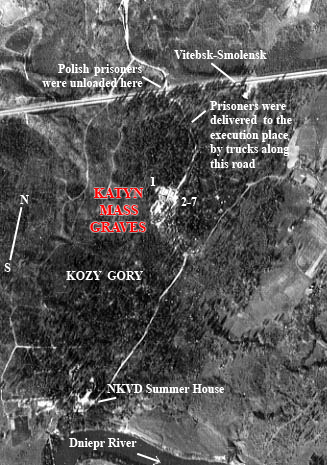
Katyn. Two German war-time posters:


Katyn victim captain Józef Baran-Bilewski, Piolish Army artillery officer. before the war participated in the Summer Olympics in Amsterdam and Los Angeles.
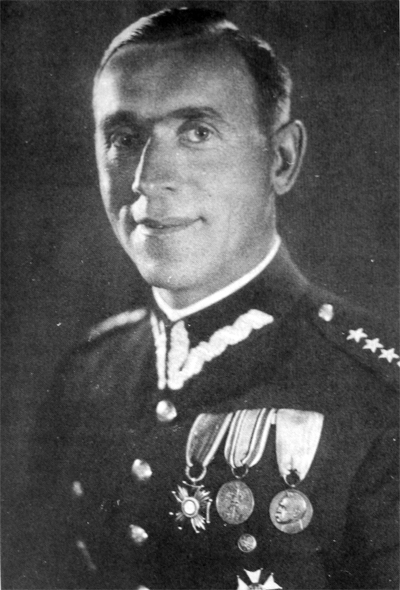
Katyn Chief Executioner. Major-General Piotr Soprunenko in 1960 and 1940(insert). Head of the POWs and Interned Department of NKVD. According Beria and Merkulov's orders he prepared plan and operationally controled execution of 15 000 Polish prisoners.
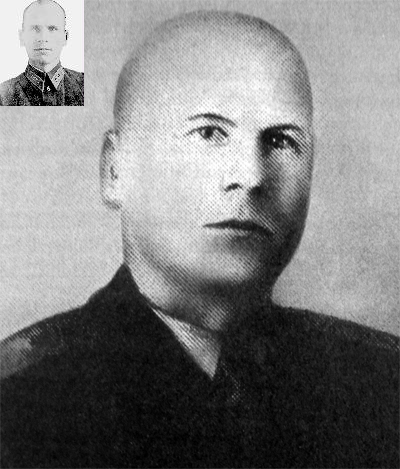
Piotr Soprunenko (right) interrogation, April 29 1991. Soprunenko was never charged in any crimes. According Russian official position, Red Army military personnel never committed any acts of genocide, they were just involved in regular crimes, which according Russian laws by 1991 were no more punishible.
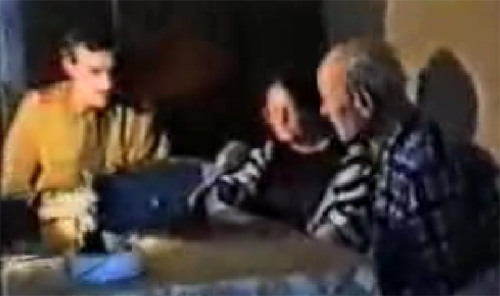
PHOTOS
From the German book "Amthches Material zum Massenmord van Katyn". Berlin, 1943.

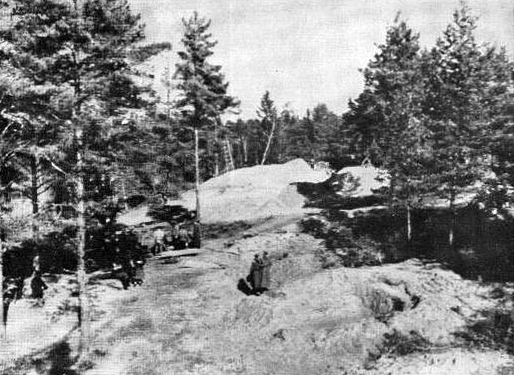
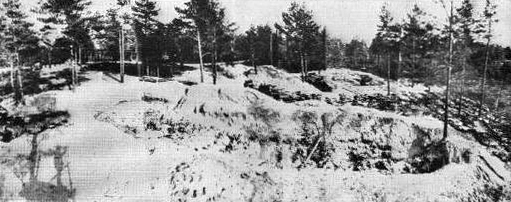


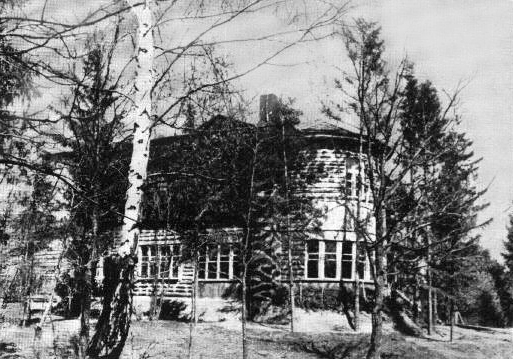
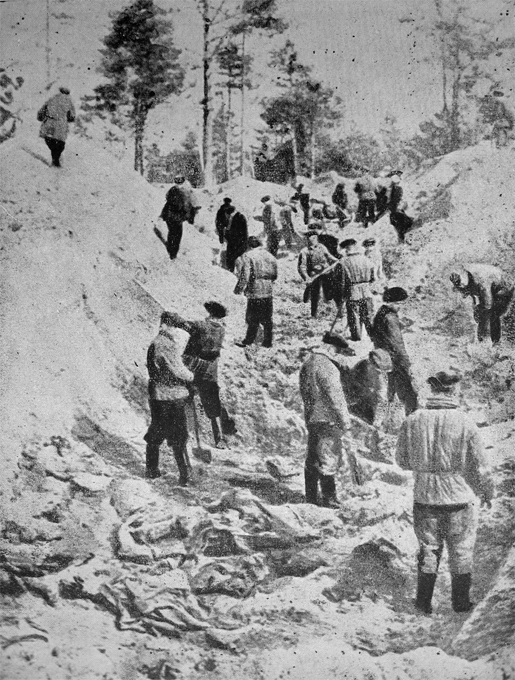

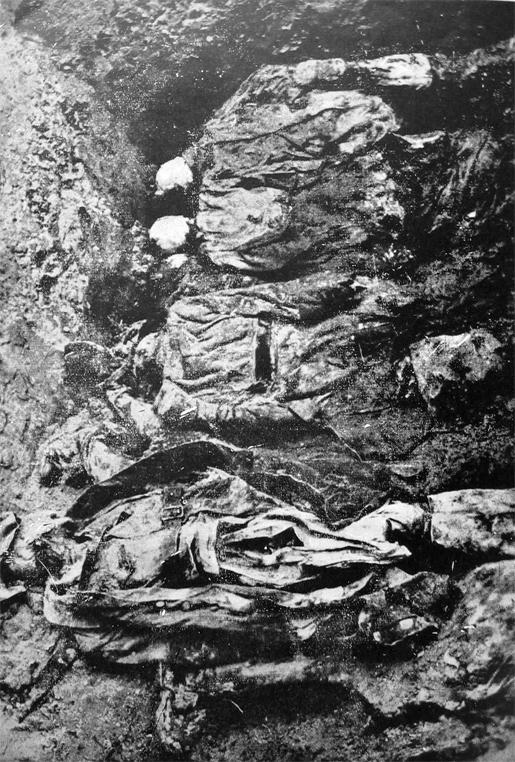
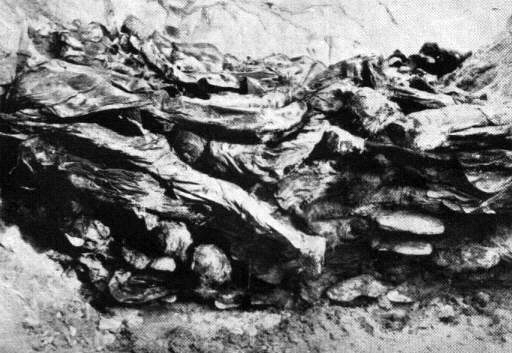

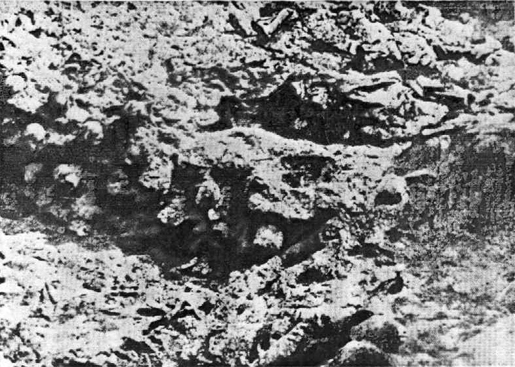 \
\
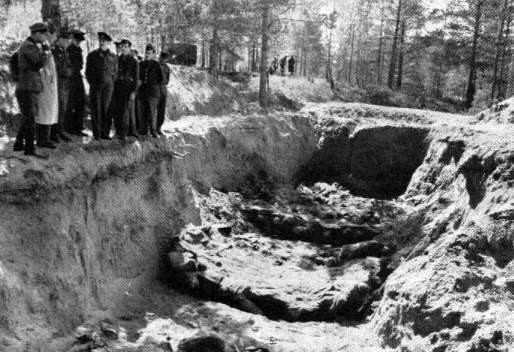
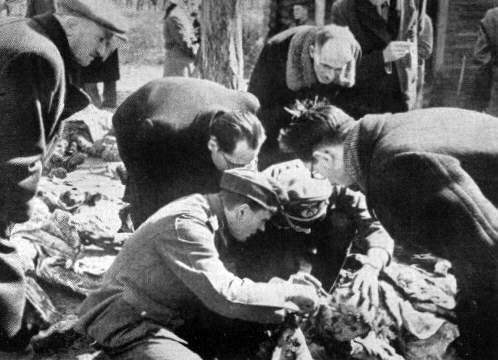


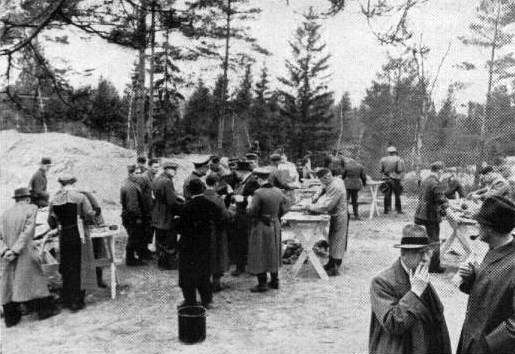
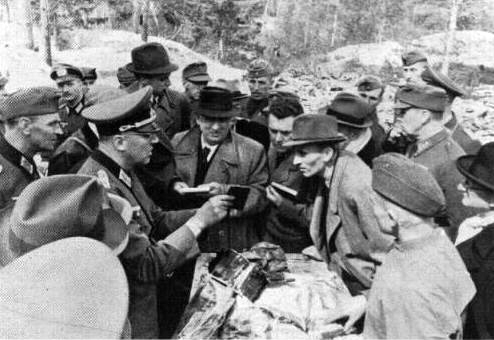
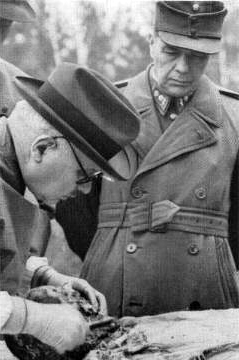

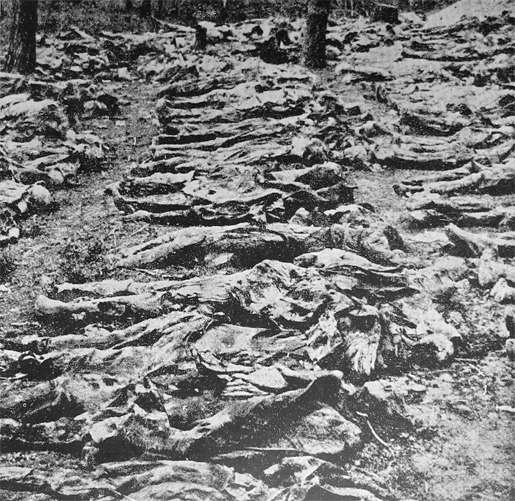
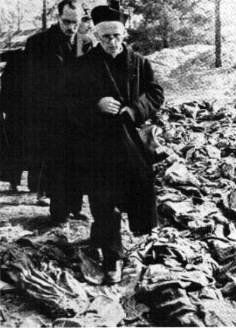

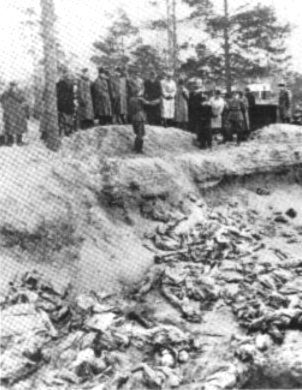

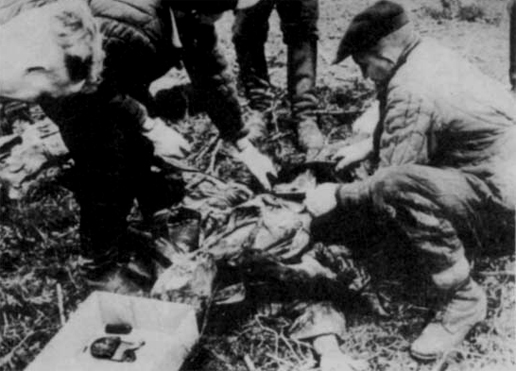
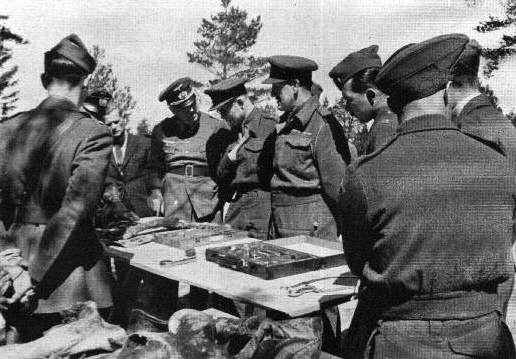




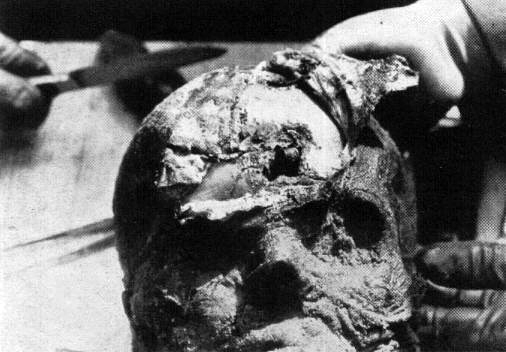

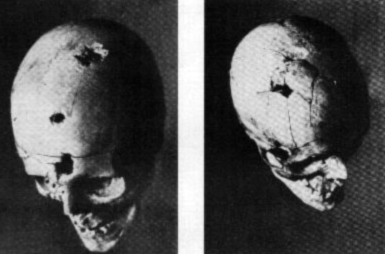
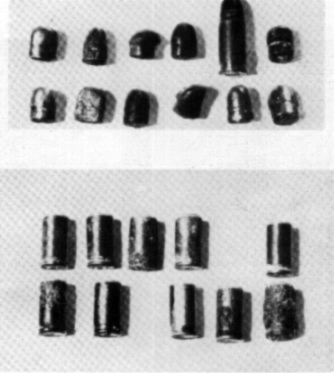

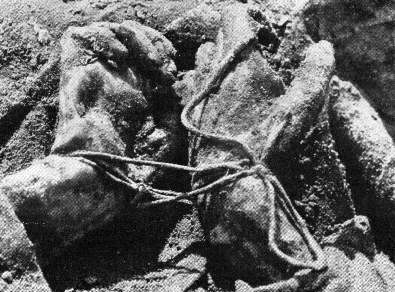
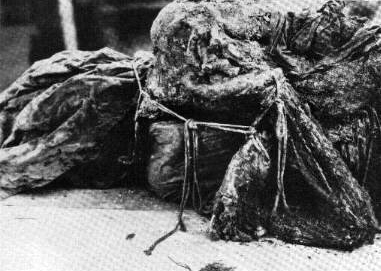
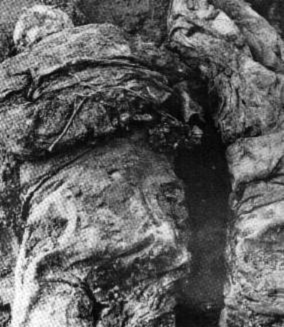
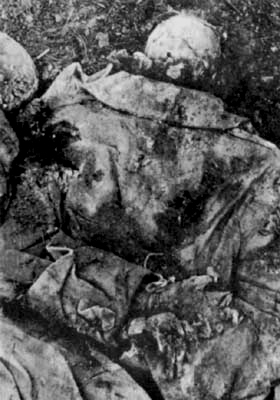
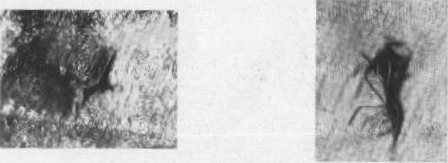

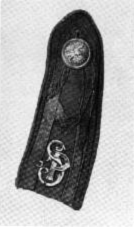
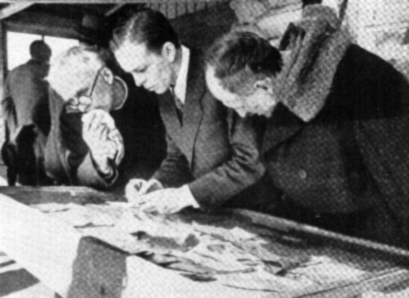



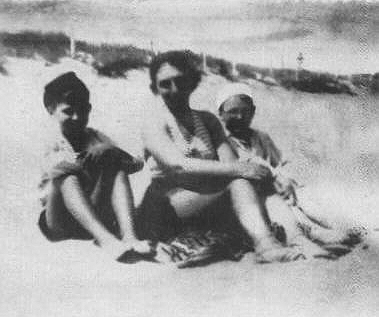
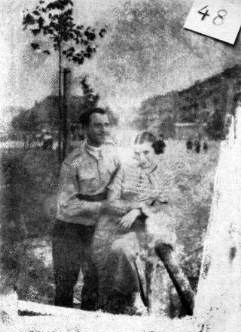

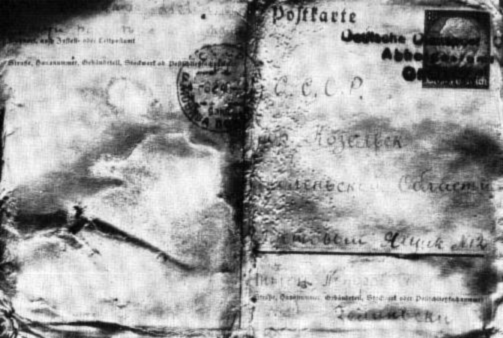

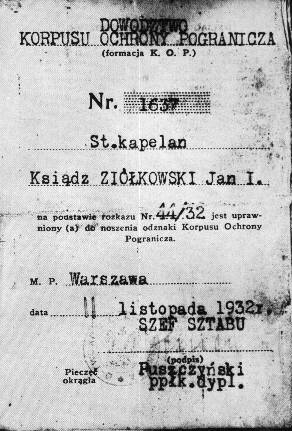
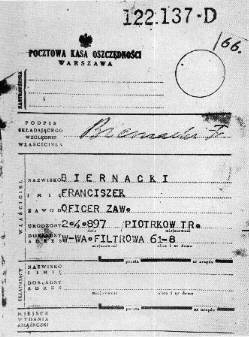
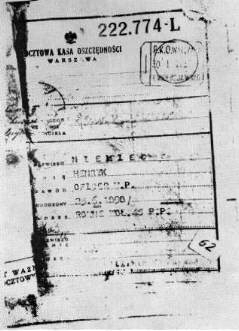
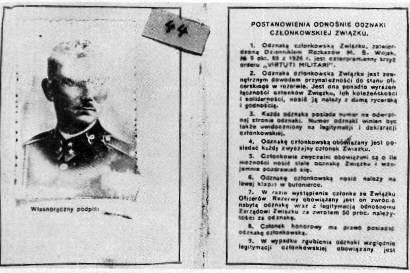
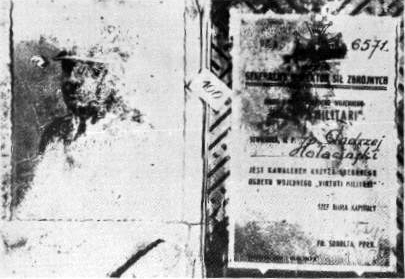

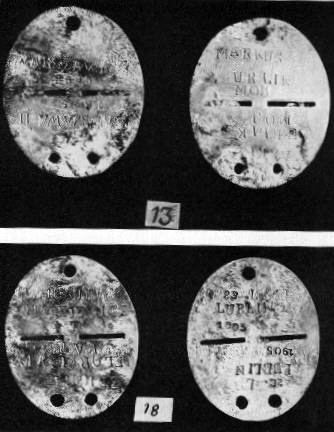
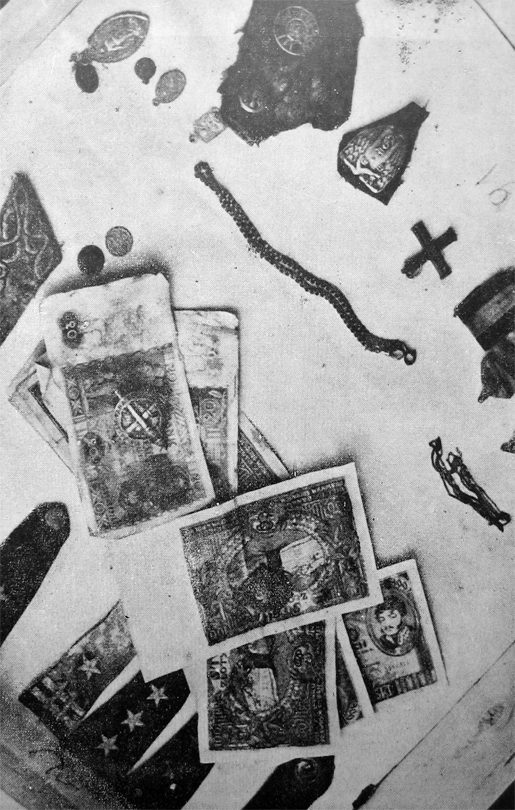

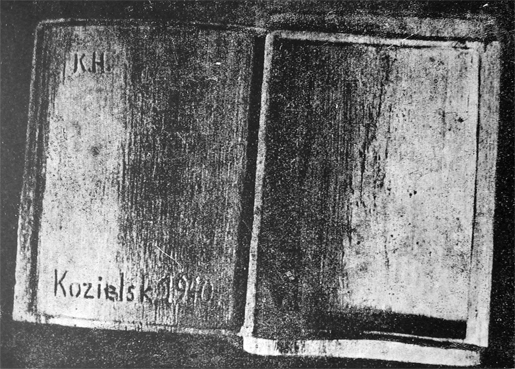
KATYN DOCUMENTS
In this memorandum, dated by March 5, 1940 Head of the USSR Commissariat of Internal Affairs Lavrenti Beria suggested to execute Polish prisoners (25700 in total) for anti-Soviet propaganda and most likely participation in anti-Soviet activities in case of their release from the Soviet custody. This decision was approved and signed by Stalin, Voroshilov, Molotov, and Mikoyan. Kalinin and Kaganovich were mentioned (near left edge of the document), but didn't sign.
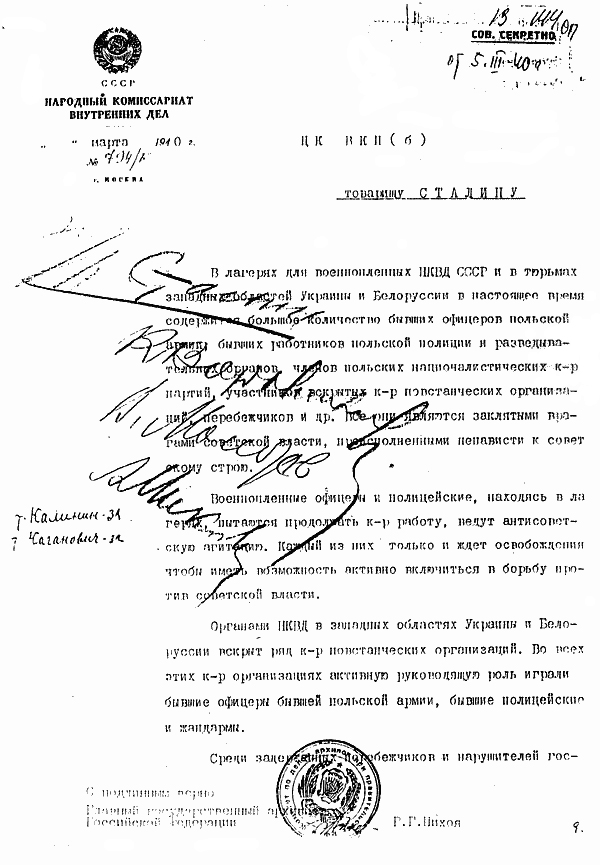
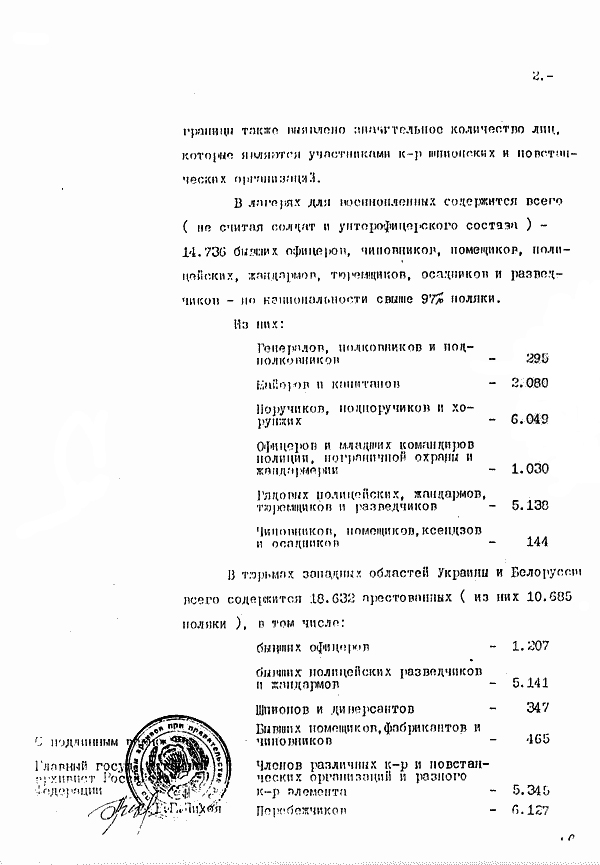
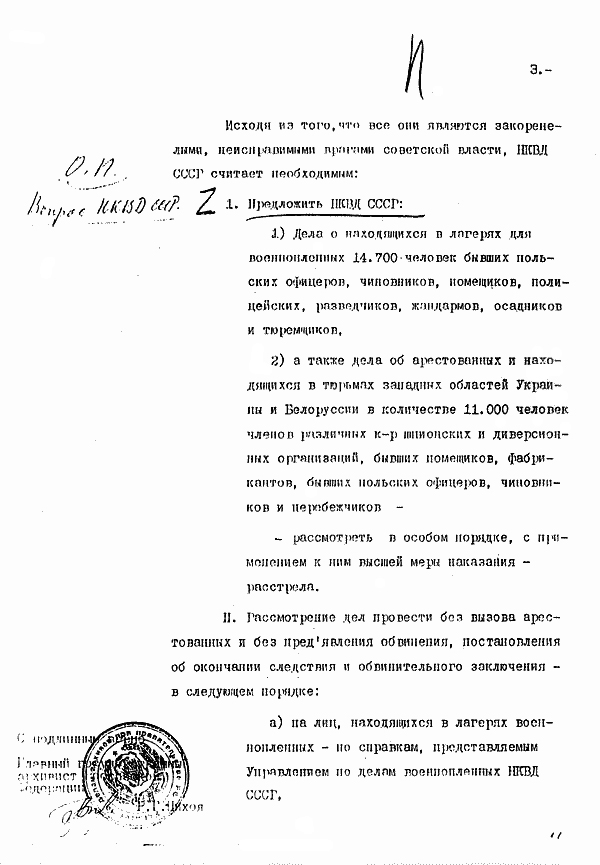

Beria's memorandum was rubber-stamped by Central Committee of the USSR Comminist Party, it promptly became an execution order (final part of the document was copied without any changes) and was sent back to Beria for implementing:
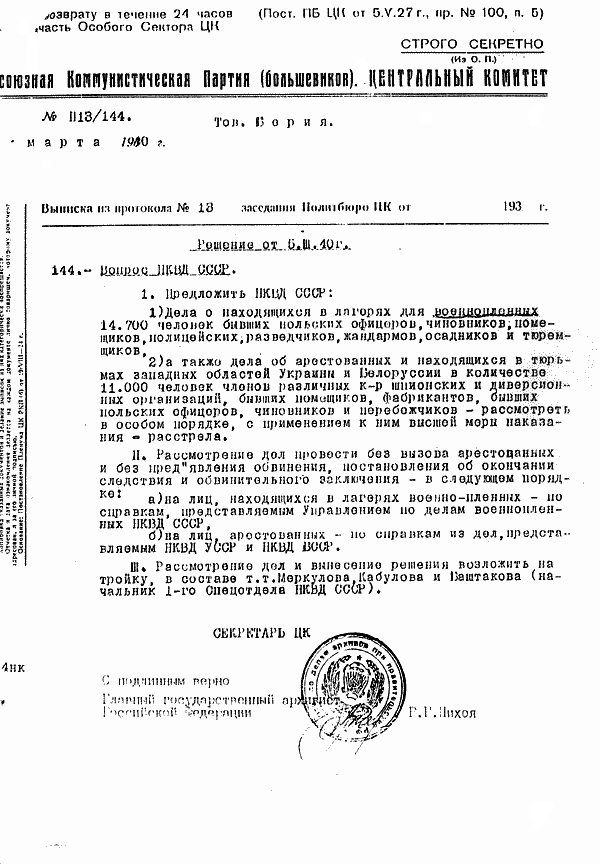
April 5, 1940, Kalinin City Jail. Receipt isued to the convoy commanding officer on "delivery" of 343 prisoners.
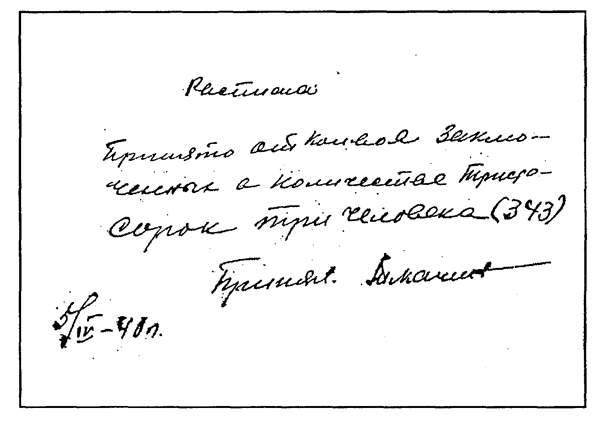
According to this NKVD coding message below: "To First command, executed #343" all prisoners were promptly executed:

April 22, 1940, Kalinin. Receipt issued by convoy commanding officer after receiving 296 prisoners in his custody.
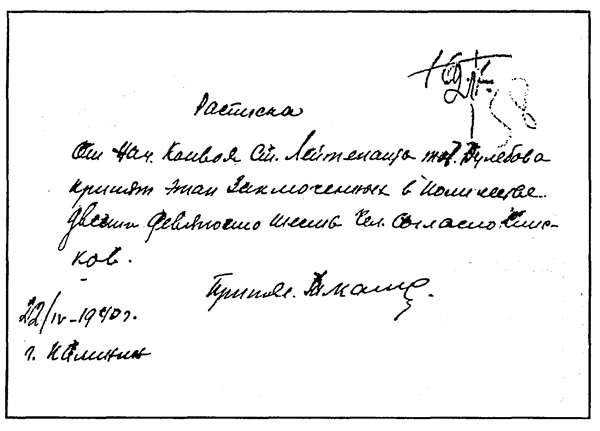
All of them were also executed according to this NKVD coding message below: "22 April executed 296"

Total number of Polish POWs "delivered" to Ostahkov camp and executed.
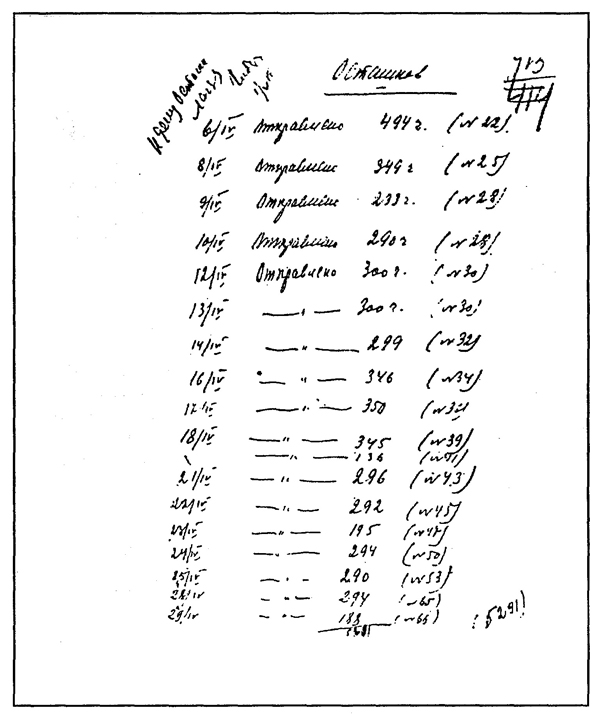
NKVD Report, compiled after May 25 1940: final numbers of the Polish prisoners, "delivered" to Ostashkov (6287), Kozelsk (4404) and Starobelsk (3896) POW camps:
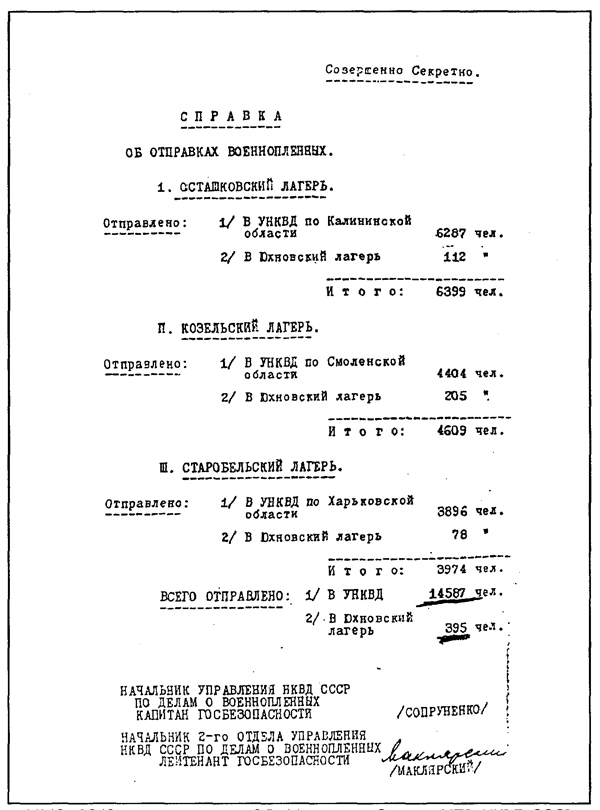
Order 119A to 136th NKVD Convoy battalion, based in Smolensk, about successful "unloading" of the Kozelsk POW camp, issued May 21, 1940. Money rewards were issued to the selected officers (50-70 roubles) and privates (25 roubles) of the 136th battalion:
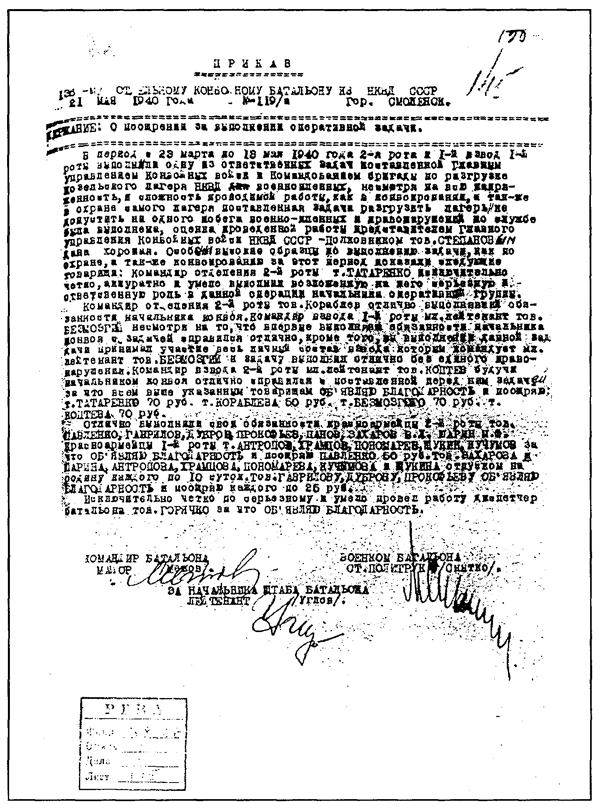
Chruschev's cover-up of Katyn story. March 3, 1959 KGB Chief A. Shelepin's asking permission to destroy all files (21837 in total) on executed Polish prisoners due to the "lack of operational or historical value".
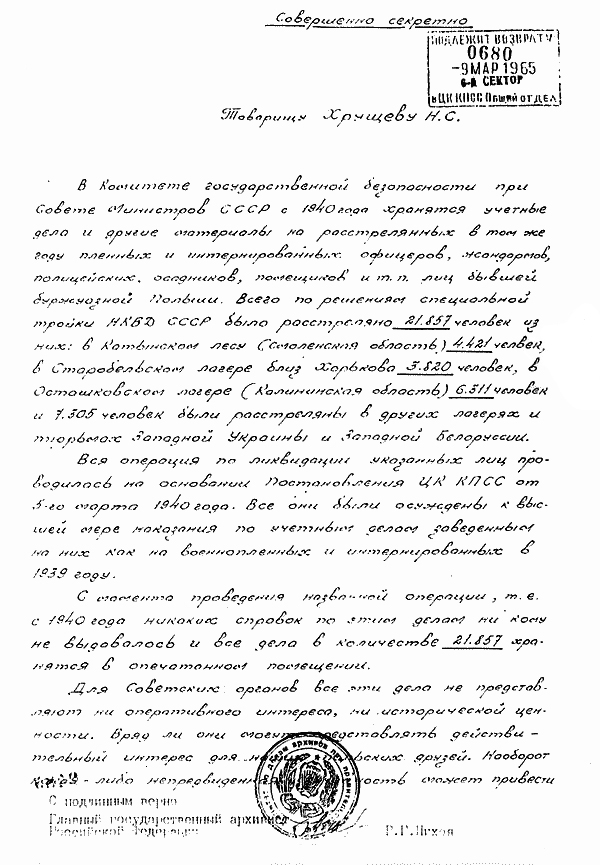
with permission draft:

KATYM MEMORIAL TODAY
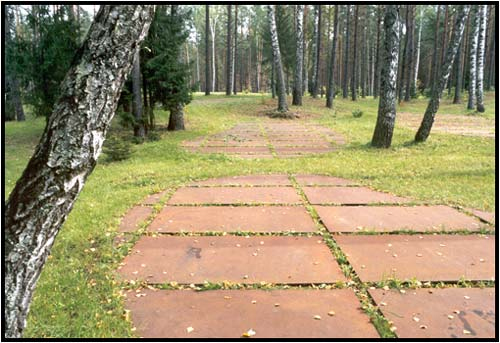
Katyn memorial. Places of original mass graves pits.
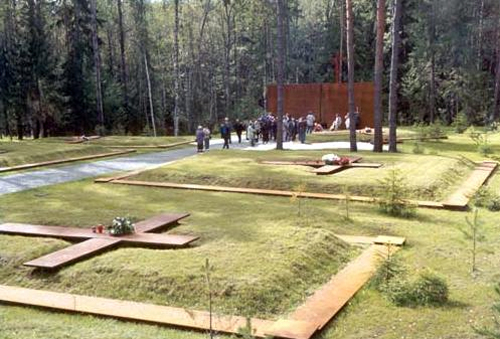
Katyn memorial. New graves, where victums were re-buried after German and Soviet exhumations.
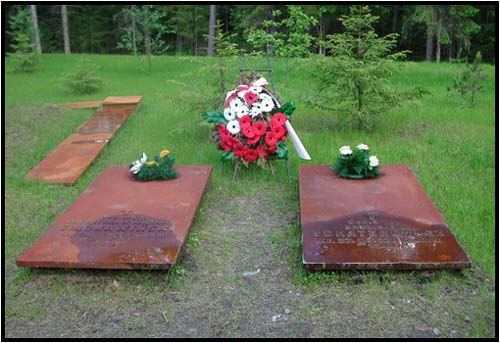
Katyn memorial. Graves of thee executed Polish Gronisław Bohatyrewiczenerals Mieczyslaw Smorawinski (Commanding General of the Second Military District - Lublin) and Bronisław BohatyrewiczBronisław BohatyrewiczBronisław Bohatyrewicz Bronisław BohatyrewiczBronisław BohatyrewiczBronisław BohatyrewiczBronislaw Bohatyrewicz (retired in 1927)
Bronisław Bohatyrewicz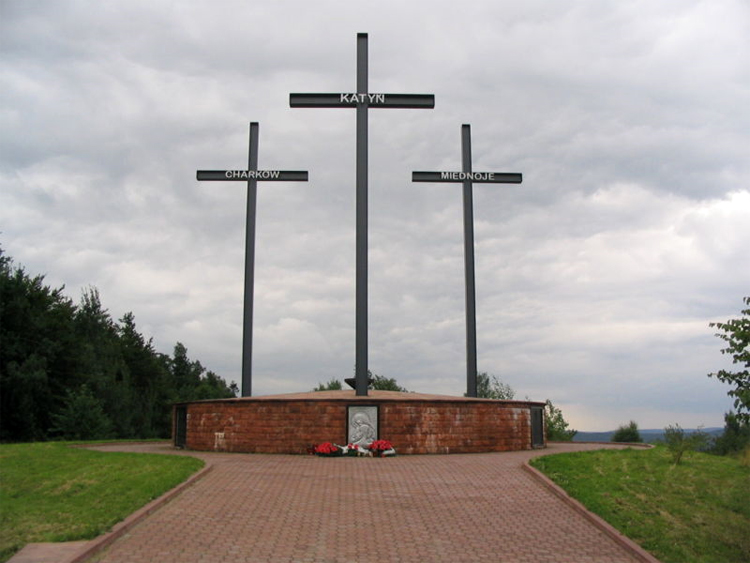
Katyn memorial. "Three Crosses" monument.
